#Living Amphibians of the World (1966)
Explore tagged Tumblr posts
Text


Paraguay horned frog (Lepidobatrachus asper) By: Gerald Durrell From: Living Amphibians of the World 1966
#paraguay horned frog#frog#amphibian#1966#1960s#Gerald Durrell#Living Amphibians of the World (1966)
435 notes
·
View notes
Text
Brief Review of Every Dinosaur/Prehistoric Documentary/Educational Short I’ve ever seen (1923-1996).
And thanks to a certain project, I’ve seen a LOT!
Evolution (1923) - This is the oldest of the bunch, a silent film. Mostly it uses modern animals to represent ancient forms, with a few statues and brief animated bits to fill things out. The only real highlight? Seeing where some of the “film real” segment from Gigantis the Fire Monster comes from!
Monsters from the Past (1923) - A short documentary with original stop motion (this was pre-The Lost World, so that’s to be expected). Triceratops, Tyrannosaurus, and Brontosaurus are the key creatures. Included as an extra on the second DVD release of The Lost World.
Prehistoric Animals (1938) - Reuses footage from The Lost World (1925) for its prehistoric segments. This will not be the last time it happens.
Prehistoric Times: The World Before Man (1952) - This thing is so quintessentially 1950s, it’s highly riff-able. It uses a mix of paintings, sculptures and some live animals to represent prehistoric life.
A World Is Born (1955) - Ya know what Fantasia needed? Overbearing Narration! That’s it. That’s what this documentary is. I saw this thing rebroadcast in the 90s on the Disney Channel, believe it or not.
The Animal World (1956) - Ray Harryhausen. Willis O’Brian. Their stop motion segment is the ONLY notable part of this documentary. This is also the only part that has seen some release in modern times, as a bonus feature on the DVD of The Black Scorpion.
Prehistoric Animals of the Tar Pits (1956) - Black and white, but also quintessentially 50s and riff-able. Aside from the bones, it shows some wooden models to represent the animals.
Journey into Time (1960) - Fantasia this is not, but it TRIES to be. Lord it tries. Or, rather, there’s a Fantasia-adjacent thing elsewhere which does the same thing. Has some unique choices for animals to represent, including showing Permian forms like Scutusaurus and Inostrancevia.
Dem Dry Bones: Archaeology, Paleontology, Identification, and Preservation (1966) - This was a lucky find, it was on Youtube for half a second. And not worth digging out, really. Stuffy, dry, and mildly condescending. It was still interesting looking at the dinosaur hall of the Smithsonian back in the 1950s.
Dinosaurs - The Terrible Lizard (1970) - The stop motion here is pretty neat, if slow and plodding, it’s refreshing after all this crap. The puppets for many of these would later be re-used for The Land of the Lost. Including Grumpy, Alice, and Spot.
NOVA: The Hot-Blooded Dinosaurs (1977) - Robert Bakker’s first appearance in a documentary. HE HAS SUCH LONG HAIR! Not bad, a little dry, with National Geographic titles. It reminds me of 1990s documentaries, just so show how long it’s taken for various ideas to filter down. Currently, it’s available on Archive.org.
Dinosaurs: A First Film (1978) - The art style for this half-animated 70s abomination makes identifying various prehistoric animals almost impossible. Almost painful to sit through. Stops with the Dinosaurs.
Dinosaurs: The Age of the Terrible Lizards (1978) - Similar to the above, but available from Rifftrax, so much more watchable. Also, it’s actually animated!
Dinosaur (1980) - Wil Vinton Claymation with Dinosaurs. A few edits of this exist, the latter works a bit better, but the original is interesting to track down. Most of the edits are audio only, so you aren’t missing anything. The dinosaur sin this are top notch for color and design. They even have Corythosaurus and Tyrannosaurus not dragging their tails!
Cosmos (1980) - the animated segment covering Evolution is still wonderful if only for the narration from Carl Sagan.
The Age of Mammals (1981) - A follow up of sorts to Dinosaurs: The Age of Reptiles. Decent stop motion if a little slow. Decent variety for the time.
64,000,000 Years Ago (1981) - A solid stop motion short film. Still worth checking out for stop motion fans. Available on Youtube legally!
Dinosaurs: Fun, Facts, and Fantasy (1981) - Nostalgic for some, but aimed at a rather young audience. Some interesting stop motion bits in here too... if awkward in that way British stop motion can be outside Aardman Studios.
Reading Rainbow “Digging up Dinosaurs” (1983) - Definitely nostalgic for me. Besides, it’s Reading Rainbow! And opens with a clip from One Million Years B.C.! What’s not to love?
Prehistoric Beast (1984) - One of the best stop motion shorts on this list. Included because it INSPIRED a documentary from it. Phil Tippett firing on all cylinders. Well worth watching. And he uploaded it on Youtube himself!
Dinosaurs, Dinosaurs, Dinosaurs (1985), More Dinosaurs (1985), Son of Dinosaur (1988), Prehistoric World (1993) - Gary Owens and Eric Boardman have a series of documentaries on dinosaurs and prehistoric life. The presenters are what really make these work. Colorful, fun, and yes, silly, these still hold a nostalgic gleam for people like me. The last one has Dougal Dixon talk about his After Man speculations. Fun times.
Dinosaur! (1985) - Hosted by Christopher Reeve, this is one of the best documentaries of its time. Reeves loved dinosaurs and was happy to work on this project with Phil Tippet behind the animation. Covers a lot in its hour long format, and well worth watching. Do you know how good this special was? When Reeve died in 2004, the Discovery Channel (or similar station) re-aired this thing as a tribute. It holds up that well!
Tell Me Why: Pre-Historic Animals, Reptiles and Amphibians (1986) - This is something I had when I was a little kid. Dry, straight forward, a “Video Babysitter” at it’s best. It consists of a narrator while looking at pictures of the Invicta Dinosaur Toys that were also on the poster.
Dinosaurs! A Fun-Filled Trip Back in Time (1987) - Wil Vinton’s Dinosaurs! tied with a short setup/framing device with the kid from the Wonder Years involving a low-animation music video (this was the MTV age) and a guide through art from various dinosaur books from the 1950s through the 1980s. Rather meh, but Wil Vinton is why we are here. This was the only way to get Wil Vinton’s short back in the day, and is the version of the short shown in Museums like The Academy of Natural Sciences.
Digging Dinosaurs (PBS-WHYY) (1988) - Something I managed to record of TV back in the day, though not much of it, about the uncovering and preparation of Avaceratops. Bone Dry.
Maia: A Dinosaur Grows Up (1988) - A VHS version of the picture book, with narration and the whole spiel. Actually not to bad for what it is, but it is what it is. The art for that book is rather wonderful.
Lost Worlds, Vanished Lives (1988) - David. Attenburrough. Need I say more? Not one of his best, but still wonderful. Hard to track down.
Dinosaurs (1989) - From the Smithsonian Institute, one of the video followups sold in various museums (I have one from the Royal Tyrell, but haven’t been able to track it down). Not great, but I’ve seen worse.
Infinite Voyage: The Great Dinosaur Hunt (1989) - A rather dry documentary, but one I find extremely relaxing and calming. Very nostalgic for me. But still dry.
Vestie Video Sitter: Dinosaurs (1989) - This is for babies. It hurt to watch.
In November, 1990, Jurassic Park (novel) was released, and thus began the great shift.
In Search of the Dragon: The Great Dinosaur Hunt of the Century (1991) - a.k.a. The Dinosaur Project, The Great Dinosaur Hunt, The Hunt for China’s Dinosaurs. Edited into a 1 hour NOVA special from a nearly two hour documentary, all about the joint Canadian/Chinese Gobi Desert Expedition in the 1980s that gave us Mamenchisaurus among many other species. With another stop in the Arctic for good measure. Some good stop motion and pencil animation for Troodon round this one out.
A&E’s Dinosuar! (1991) - There’s so many things named “Dinosaur” that I have to specify. Hosted by Walter Cronkite, this is rather dry, but still entertaining documentary series has some nightmare-fuel puppet-work. The ‘sad’ music gets caught in my head sometimes when I think about it. It is 4 episodes long. “The Tale of a Tooth”, “The Tale of a Bone”, “The Tale of an Egg”, and “The Tale of a Feather”
T. Rex: Exposed (1991) - a Nova Documentary on T. Rex. Not too bad overall, focusing on the Wrankle Rex unearthing. Parts of it are available on Youtube, but not all of it.
The Case of the Flying Dinosaur (1991) - the third in the “NOVA” 91 trilogy, this covers the bird-dinosaur connection as it was still contentious at the time.
PBS’ The Dinosaurs! (1992) - A gold standard for documentaries on dinosaurs. The hand drawn animation with colored pencil style still hold up today. The narrator has a bit of an accent and pronounces “Dinosaur” oddly, but that is the only complaint I can really give. It has 4 episodes: “The Monsters Emerge”, “Flesh on the Bones”, “The Nature of the Beast”, “Death of the Dinosaurs.”
Muttaburrasaurus: Life in Gondwana (1993) - A half-hour short about dinosuars and mesozoic life in Australia. Solid stop motion animation. Australian Accents makes it fun to listen too.
NOVA: The Real Jurassic Park (1993) - Jeff Goldblum narrates this bit of scientists going on about “But what if we really did it?” Quite fun, lotta fun details the movies and even the books didn’t get into. My favorite bit had Robert Bakker talking to a game keeper at the Rockefeller Refuge in a Louisiana Cypress Swamp about what could happen if they kept a few dinosaur there (Edmontosaurus, Triceratops, and T. Rex). Namely, he talks about housing ‘about a thousand” Edmontosaurs on the 86K acre facility, with 2 or 3 mated pairs of Rexes. It’s fun getting numbers like that.
Bill Nye the Science Guy “Dinosaurs” (1993) - BILL! BILL! BILL! BILL! BILL! Not a bad kids entry for documentaries. Available from Netflix.
Paleoworld (1994-1997) - Running originally for 4 years, and being revamps once along the way, this rather dry, “Zoom in on paleoart” style of documentary was a good holdover for bigger things, and covered some pretty niche topics. Much of the later version has been uploaded to youtube.
Dinosaur Digs: A Fossil Finders Tour (1994), Dinosaurs: Next Exit (1994) - These films hurt me. They hurt me so much. I’ve seen some painful things, but these are hour long tour advertisements for road trips with annoyingly earworms. Available on youtube, but I ain’t linking anything!
Eyewitness: Dinosaur (1994) - Not a bad documentary, but I still hold a grudge on it for replacing Wil Vinton’s work at my local museum! Still, it is narrated by Martin Sheen. The clip selection is wide and varied, but we’re still getting The Lost World (1925) footage.
Planet of Life (1995) - This documentary series is rather dry, but boasts some interesting coverage of topics. Though some of it’s conclusions regarding dinosaurs are... not great. Still, the episode “Ancient Oceans” is a favorite of mine.
Once Upon Australia (1995) - The bests stop motion documentary on Australia’s prehistory. Has some humor to is, and Australian fauna that it does cover is solid. Though finding out how one of the animals is spelled, ( Ngapakaldia) drove me nuts for literally decades.
Dinosaurs: Myths and Reality (1995) - Like a little more polished episode of Paleoworld, with a lighter-voiced narration, this covers common myths about dinosaurs. Overall, a Meh. But it has a LOT of movie clips. Which makes sense given it was funded by the Disney Channel!
The Ultimate Guide: T. Rex (1995) - The Ultimate Guide series of docs were overall rather solid, as was the Tyrannosaurus one. Stop Motion animation along with puppets and some minor CG help round out the normal talking heads and skeleton mounts. Along with a solid narrator, it has a real mood to it.
The Magic School Bus “The Busasaurus” (1995) - The original Magic School Bus was a solid series, and their episode on Dinosaurs bucks trends even the reboot didn’t cover. The core thrust here wasn’t just dinosaur information, but the idea that Dinosaurs were not Monsters, but animals. And they conveyed it in a unique way.
I may do more of these mini-reviews, but there are a LOT of documentaries post The Lost World: Jurassic Park that don’t have as much easy access. Like, I’ve seen them, but digging out links/citing places to watch them is a lot harder.
21 notes
·
View notes
Photo


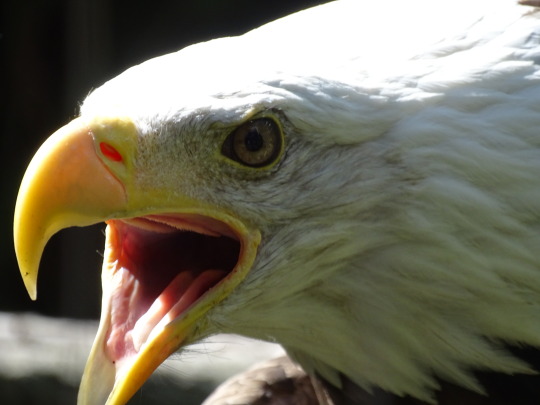
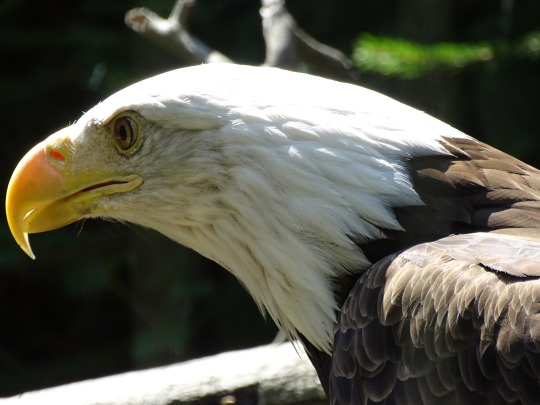




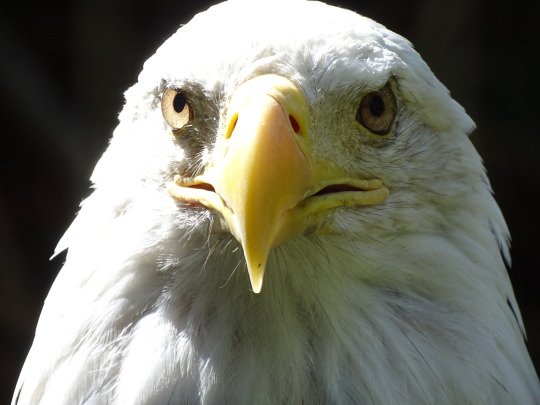

National American Eagle Day
The bald eagle is the national symbol and emblem of the United States, as well as the country's national bird. It also is on the obverse side of the Great Seal of the United States. Today we celebrate the bald eagle, on the anniversary of the day in 1782 when the seal bearing its image became official. Besides being celebrated for being on the Great Seal and for being the country's symbol and national bird, the eagle is celebrated today for its recovery after almost becoming extinct, for the values and ideals it has come to represent, and for its importance to American folklore and society.
In 1776, Benjamin Franklin, John Adams, and Thomas Jefferson were tasked with creating a seal for the newly formed country. Their design was not accepted by Congress, and a few other committees were formed over the next few years where various people worked on designing the seal. Finally, after six years, a design was approved and became official on June 20, 1782.
The Great Seal is attached to many official documents, such as treaties and presidential proclamations. There is an official Great Seal kept in a mahogany cabinet in Exhibit Hall at the State Department in Washington D.C., which is used to stamp the seal on documents. The obverse and reverse of the seal can also be found on the back side of the one dollar bill.
The eagle is at the center of the obverse side of the Great Seal. It is holding an olive branch in its right talon and thirteen arrows in its left talon. The olive branch symbolizes the country's commitment to peace, while the arrows symbolize the country's readiness for war. The thirteen arrows also represent the original colonies. The eagle holds a scroll in its beak, on which is written the original national motto, "E pluribus unum," which means "out of many, one." This too is a reference to the original thirteen colonies, which came together to form a new country. This side of the seal is considered to be the coat of arms of the United States.
American Eagle Day has gone by—or goes by—various names such as Bald Eagle Day, National Bald Eagle Day, National Eagle Day, National American Eagle Day, and American Bald Eagle Day. Regardless of its name, it takes place on June 20 and celebrates the same thing. On January 28, 1982, President Ronald Reagan issued a proclamation for National Bald Eagle Day, after a joint resolution of Congress designated 1982 as the Bicentennial Year of the American Bald Eagle, and June 20, 1982, as National Bald Eagle Day. American Eagle Day was proclaimed by President Bill Clinton in 1995, as well as by Tennessee Governor Don Sundquist, after urging from the American Eagle Foundation.
Reagan and Clinton's proclamations did not make it an official annual day for the bald eagle, though, but the public has celebrated the eagle annually on today's date, nonetheless. Furthermore, almost all states have since made the day an official observance for the bald eagle. Beginning in 2007, the United States Senate started passing resolutions marking the day. If a joint resolution with the House of Representatives is passed, American Eagle Day would permanently be established. Then, a presidential proclamation would just need to be issued each year, as presidential proclamations don't renew.
Bald eagles are only found in North America, and their numbers began going down after Europeans arrived on the continent. In 1782, there were between 25,000 and 75,000 bald eagles in the lower 48 states, but by the late 1800s, they began becoming scarce. This was because of a few reasons. They were seen as vermin and a threat to livestock and were shot by farmers. Others saw them as game. Western movement in the United States destroyed habitats and food sources. In 1940, Congress acted to protect the birds by passing the Bald Eagle Act.
It was also around this time, though, just after World War II, when DDT began being used. It got rid of mosquitos and other small agricultural pests, but it also had a detrimental effect on bald eagles. Small animals ingested the chemical and were in turn eaten by eagles, affecting them and their eggs. Eggs became thinner, causing them to break. By 1963, only 417 mating pairs of bald eagles were left in the lower 48 states. The banning of DDT in 1972 is seen as the most important thing to help the recovery of the bald eagle. The Endangered Species Acts of 1966 and 1978 also helped with the restoration of the birds. It took more than laws to bring back the birds, though. Many birds were bred in captivity and reintroduced to places throughout the United States. The work and efforts of federal and state fish and wildlife agencies, scientists, environmentalists, conservationists, and groups like the American Eagle Foundation all were fundamental to the restoration of the bald eagle population.
The birds were removed from the endangered species list in 1995, and in June of 2007 their status was changed from "threatened" to "protected." By the late 2000s, there were estimated to be 10,000 nesting pairs. Some believe there are now about 15,000 nesting pairs in the lower 48 states. Bald eagles still face threats, however, such as loss of habitat, contaminants, and diseases, so it is important that they remain protected.
Bald eagles are not actually bald but have white plumage on their heads. Young bald eagles mainly have brown heads. Eagles eat fish, as well as small animals such as ducks, crabs, gulls, rabbits, and amphibians. Sometimes they chase down other birds and steal food from them, scavenge for food in dumpsters, or eat carrion—decaying dead animals. They can dive at speeds of 100 miles an hour to catch their prey, and otherwise fly at a speed of about 30 miles an hour.
Bald eagles usually mate for life, after pairing up at about the age of four or five. Females lay two or three eggs, and both parents incubate and protect them from predators such as ravens, gulls, and squirrels. Both parents also feed the young, as well as build the nest the family lives in. The nests are made with sticks and lined with softer materials such as grass and feathers. They may be used multiple years, and new material is added to them each year. The nests are usually two to four feet deep and four to five feet wide. The Guinness World Record for the largest bird's nest is of a bald eagle nest. It was twenty 20 feet deep and 9.5 feet wide.
Female bald eagles are larger than males, which is the easiest way to tell the sexes apart, as they both have the same plumage pattern. Full grown eagles have wingspans of about seven feet. The birds often live to be about 30 to 35 years, and it is believed the oldest wild bald eagle lived to be 38.
The American Eagle Foundation is instrumental in organizing events for American Eagle Day each year. Conservation and educational organizations hold public outreach events, such as workshops and lectures, to show the importance of protecting bald eagles and other wildlife. Many citizens also celebrate the eagle in various other ways on the day.
How to Observe
Visit the American Eagle Foundation or learn more about the foundation in general. They put on an event each year that you could attend, but if you are unable to, there are live eagle nest cameras on their website that you could view instead, and you could donate to support the foundation's work as well.
You also could look for other events closer to your home that are taking place. On your own, you could learn more about bald eagles by reading about them. One famous bald eagle you could learn about is Old Abe. You could also visit a zoo to see one or find some out in the wild. If you are interested in the historical significance of the day, you could visit the Great Seal in Washington D.C. Other ways the day could be celebrated are by flying a flag on a flagpole with an eagle on top, listening to the Eagles, or listening to songs about eagles.
As it is not yet an official national day, you could write to your governor or the President, asking them to support the day. It may be even more fitting to write to the leadership of the House of Representatives, in order to ask them to join the Senate in passing a joint resolution to make American Eagle Day permanent.
Source
#National American Eagle Day#NationalAmericanEagleDay#20 June#USA#Bronx Zoo#New York City#Bald Eagle#bird#original photography#head#beak#what a tongue#feathers#close up#detail#summer 2019#Birds of Prey#free attraction#Northeastern USA#AmericanBaldEagleDay#NationalBaldEagleDay#animal#outdoors#nature#fauna
1 note
·
View note
Text
P2-Interactive Learning Game
Brainstorming and initial thoughts


Lo-fi prototype







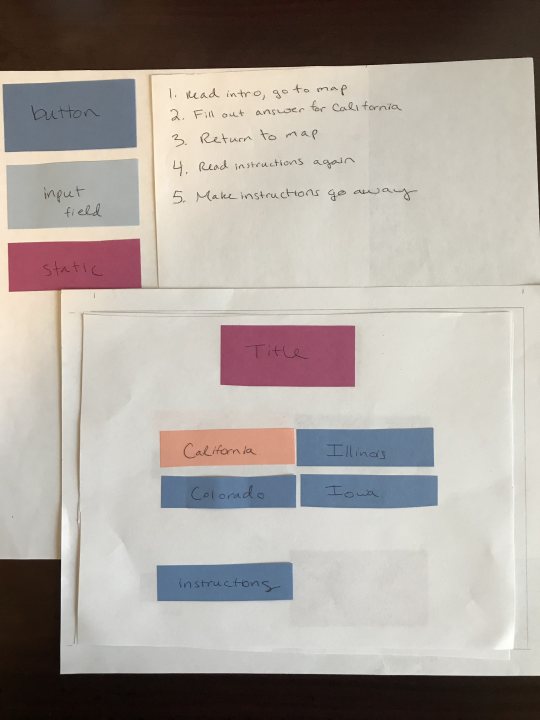
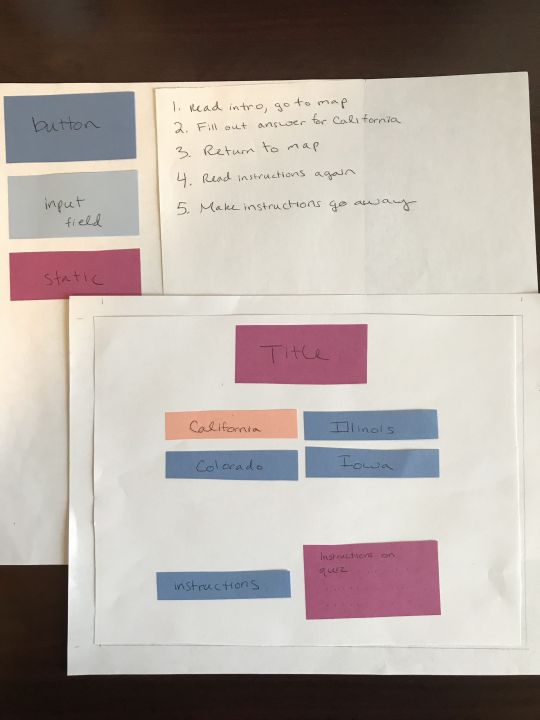
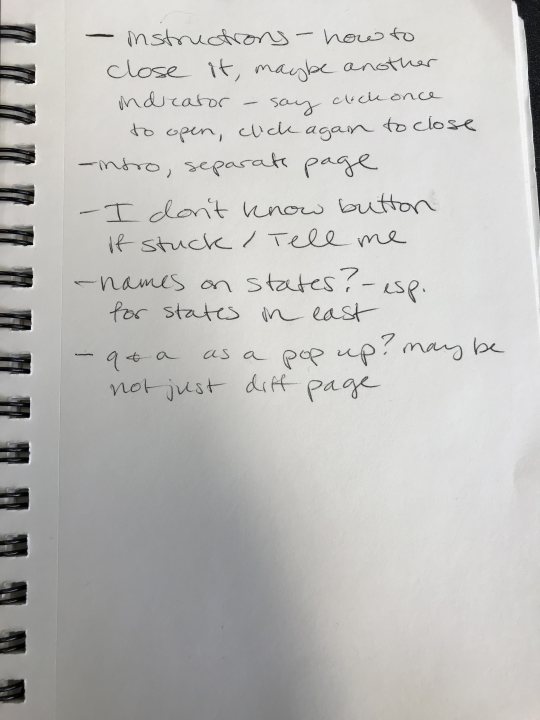
After receiving feedback from classmates and my professor, I decided to map out ten national parks with buttons instead of mapping out 50 states with buttons.
Moodboards


Style Tile

Static Digital Layout
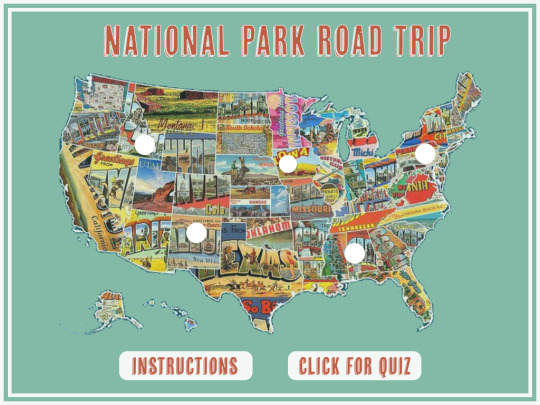


Notes


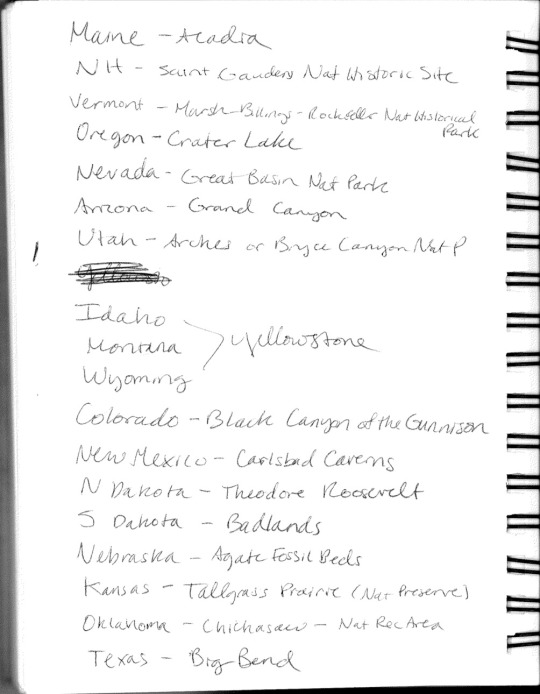
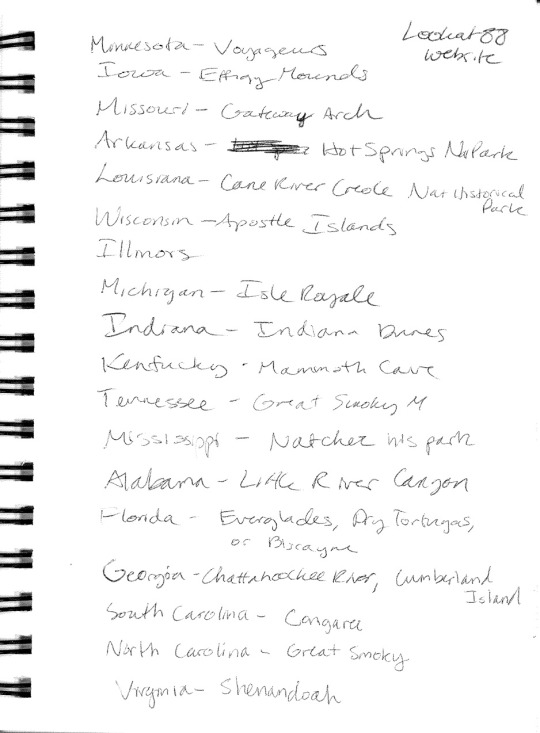


Olympic Park:
Officially national park in 1938.
Encompassing 922,651 acres, the park protects a vast wilderness, thousands of years of human history, and several distinctly different ecosystems, including glacier-capped mountains, old-growth temperate rain forests, and over 70 miles of wild coastline.
More than 1,100 species of plants live in Olympic's meadows and forests.
Just offshore, whales, dolphins, sea lions, seals, and sea otters feed in the Pacific Ocean. Invertebrates of countless shapes, sizes, colors and textures inhabit the tide pools.
Some species, like raccoons, beaver and mink, live mostly in the lowlands. Deer, elk, cougars and bears, range from valleys to mountain meadows. Park waters are home to some of the healthiest runs of Pacific salmon outside of Alaska. Over 300 species of birds live in the area at least part of the year, from tiny penguin-like rhinoceros auklets offshore to golden eagles soaring over the peaks.
Endemic species like the Olympic marmot, Olympic snow mole and Olympic torrent salamander are found here and nowhere else in the world.
Eight contemporary tribes of the Olympic Peninsula - the Hoh, Ozette, Makah, Quinault, Quileute, Queets, Lower Elwha Klallam, and Jamestown S'Klallam - have lived in this area and have strong relationships with the lands and waters within the park.
Yosemite:
Within its nearly 1,200 square miles, you can find deep valleys, grand meadows, ancient giant sequoias, a vast wilderness area, and more.
The expansive park’s 747,956 acres or 1,169 square miles, nearly 95 percent of which are designated Wilderness, are home to hundreds of wildlife species, and over a thousand plant species.
Yosemite supports more than 400 species of vertebrates, including fish, amphibians, reptiles, birds, and mammals.
Many waterfalls, specifically 2,425-foot Yosemite Falls that ranks as the tallest in North America, flowing down into the scenic Valley meadows.
Visitors can explore 800 miles of hiking trails and 282 miles of scenic roadways.
Yosemite is the nation’s 3rd national park, but it sparked the idea of national parks. Twenty-six years before it was a national park, President Lincoln signed the Yosemite Land Grant on June 30, 1864, protecting the Mariposa Grove and Yosemite Valley. It was the first time the government protected land because of its natural beauty so people could enjoy it.
Yosemite’s granite rock formations glow like fire at sunset. Sunlight illuminates El Capitan and Half Dome in brilliant reds and oranges.
Yosemite is one of the few places in the U.S. where you can see a rainbow at night. Yosemite is world-famous for its waterfalls and the rainbows that can appear in them. But very few people know about the park’s lunar rainbows.
Glacier Park:
Pristine forests, alpine meadows, rugged mountains, and spectacular lakes.
Over 700 miles of trails.
Glacier Park's varied climate influences and its location at the headwaters of the Pacific, Atlantic and Hudson Bay drainages have given rise to an incredible variety of plants and animals.
There are 276 species of birds are found in the park, Glacier hosts 6 species of amphibians, 71 species of mammals call Glacier home. There are only three species of reptiles in the park, with a fourth suspected to be present. It is nearly impossible to know how many species of insect live in Glacier, when a single rotting log alone could host thousands. Glacier's waters host a complicated mix of native and invasive species.
The park had over 100 glaciers when it was established in 1910. By 1966, 35 glaciers remained. In 2015, only 26 met the size criteria to be designated active glaciers. Snow avalanches, ice flow dynamics, and variations in ice thickness cause some glaciers to shrink faster than others. All the glaciers have receded since 1966.
Glacier National Park is a part of the world’s first international peace park. Vision for a park was to celebrate peace and friendship between the United States and Canada.
Yellowstone:
On March 1, 1872, Yellowstone became the first national park to enjoy the unique hydrothermal wonders. Preserved within are Earth's most active and diverse geysers, hot springs, mudpots, and fumaroles.
At 28,000 square miles.
Abundant and diverse: 67 species of mammals, 330 species of birds, 16 species of fish, 5 species of amphibians, 6 species of reptiles.
A volcano, geysers and other thermal features, earthquakes, and glaciers shape Yellowstone's landscape.
Half the world’s hydrothermal features are found at Yellowstone. Yellowstone National Park preserves more than 10,000 hydrothermal features -- an extraordinary collection of hot springs, mudpots, fumaroles, travertine terraces and -- of course -- geysers.
Microorganisms called thermophiles -- meaning “heat loving” -- live in these features and give the park its brilliant colors.
Old Faithful erupts more frequently than any of the other large geysers -- around 17 times a day.
World-renowned for its bison herds.
One of the world’s largest active volcanoes lies beneath Yellowstone. The first major eruption of the Yellowstone volcano occurred 2.1 million years ago and covered more than 5,790 square miles with ash.
Grand Teton:
Located in northwestern Wyoming
The elevation of the park ranges from 6,320 feet on the sagebrush-dominated valley floor to 13,770 feet on the windswept granite summit of the Grand Teton.
Long, snowy, and bitterly cold winters make the climate of Jackson Hole unforgiving. Coldest temperature ever recorded in Grand Teton National Park was -63°F, and snow often blankets the landscape from early November to May.
Grand Teton National Park was established in 1929 and then again in 1950. In 1929, President Calvin Coolidge went against enormous public opposition and approved the original 96,000-acre park, which encompassed the Teton Range and six glacial lakes. In 1943, President Franklin D. Roosevelt established the 210,000-acre Jackson Hole National Monument to protect the remaining federal lands on the valley floor. In 1950, President Harry S. Truman and Congress merged the monument, the national park and a 35,000-acre donation from John D. Rockefeller to create the 310,000-acre Grand Teton National Park.
Earthquakes gave rise to the 40-mile-long Teton Range, which sits on a fault line. The west block of land rose upward to form the mountains while the east block of land dropped down to form the valley called Jackson Hole. The Tetons are the youngest range in the Rocky Mountains and some of the youngest mountains in the world.
https://www.nathab.com/articles/us-national-parks/yellowstone/six-facts-about-grand-teton/
Zion:
Utah's First National Park.
Located in Washington, Iron, and Kane Counties in southwestern Utah. Within its 232 square miles are high plateaus, a maze of narrow, deep, sandstone canyons, and the Virgin River and its tributaries. Zion also has 2,000-foot Navajo Sandstone cliffs, pine- and juniper-clad slopes, and seeps, springs, and waterfalls supporting lush and colorful hanging gardens
Approximately 78 species of mammals, 30 species of reptiles, 7 species of amphibians, 8 species of fish, and 291 species of birds.
The geologic formations of Zion--formed over approximately 250 million years.
Before it was a national park, Zion was a national monument. The park was first protected in 1909 when President William Howard Taft designated Mukuntuweap National Monument using the power of the 1906 Antiquities Act. In the 10 years until it became a national park, it was expanded, and its name was changed to Zion.
Zion National Park's 2,000-foot sandstone cliffs are world renowned for their big wall climbs. Construction began on a 25-mile stretch of road to connect Zion to the Grand Canyon and Bryce Canyon. The 1.1-mile-long tunnel cuts through the vertical sandstone cliffs of Zion, blends in with the surrounding landscape and includes windows to provide views of Zion Canyon.
Grand Canyon:
Unique combinations of geologic color and erosional forms decorate a canyon that is 277 river miles (446km) long, up to 18 miles (29km) wide, and a mile (1.6km) deep.
On February 26, 1919, Grand Canyon became a National Park.
Is a World Heritage Site, encompasses 1,218,375 acres and lies on the Colorado Plateau in northwestern Arizona.
Over 1,500 plant, 355 bird, 89 mammalian, 47 reptile, 9 amphibian, and 17 fish species are found in park.
The Grand Canyon is bigger than the state of Rhode Island. The Grand Canyon is a mile deep, 277 miles long and 18 miles wide. While the park doesn’t include the entire canyon, it does measure in at a whopping 1,904 square miles in total. In comparison, Rhode Island is around 1,212 square miles.
Tucked within the Grand Canyon are an estimated 1,000 caves, and of those, 335 have been recorded. Even fewer have been mapped or inventoried. Only one cave is open to the public -- the Cave of the Domes on Horseshoe Mesa.
The Grand Canyon is one of the most visited national parks in the United States. An estimated 5.9 million people visit the Grand Canyon a year, making it the second most popular national park following just behind the Great Smoky Mountains of North Carolina and Tennessee.
The Grand Canyon was carved over some 6 million years. Geological activity and erosion by the Colorado River created the Grand Canyon as we know it today.
Rocky Mountain:
415 square miles encompass and protect spectacular mountain. environments. Trail Ridge Road crests at over 12,000 feet, along with over 300 miles of hiking trails, wildflowers, wildlife.
Rocky has a section just for butterflies. Over 140 species flutter around these high elevations.
Rocky Mountain is one of the nation’s highest national parks. Elevations from 7,860 feet to 14,259 feet.
Maze of evergreen trees covers the mountainsides in subalpine areas. Hidden among the trees are crystal-clear lakes and fields of wildflowers. Approximately one-third of this national park is above the limit where trees grow in northern Colorado (around 11,500 feet above sea level), creating the alpine tundra ecosystem.
Completed in 1932, Trail Ridge Road was called a "scenic wonder road of the world." The highest continuous paved highway in the nation, drivers will climb 4,000 feet in a matter of minutes.
Park is home to more than 60 species of mammals, including elk, bighorn sheep and moose. Park has more than 280 recorded bird species, six amphibians, one reptile (the harmless garter snake), 11 species of fish and countless insects, and a large number of butterflies.
Great Smoky:
World renowned for its diversity of plant and animal life, the beauty of its ancient mountains, and the quality of its remnants of Southern Appalachian mountain culture. America's most visited national park.
Encompassing over 800 square miles in the Southern Appalachian Mountains, no other area of equal size in a temperate climate can match the park's diversity. Over 19,000 species have been documented in the park and scientists believe an additional 80,000-100,000 species may live here.
One of the most stunning and rare inhabitants of the national park is the Eastern Hellbender Salamander, the 3rd largest salamander in the world. The Smokies are known as the Salamander Capital of the World and are home to 24 species of salamanders.
Bears inhabit all elevations of the park. Though populations are variable, biologists estimate that roughly 1,500 bears live in the park. Equals a population density of approximately two bears per square mile.
Over 1,500 kinds of flowering plants are found in the park, more than in any other North American national park.
Cades Cove is a broad, verdant valley surrounded by mountains and is one of the most popular destinations in the Great Smokies. Large numbers of white-tailed deer are seen, and sightings of black bear, coyote, ground hog, turkey, raccoon, skunk, and other animals are also possible.
Protected in the park are some 65 species of mammals, over 200 varieties of birds, 67 native fish species, and more than 80 types of reptiles and amphibians.
Acadia:
Seven peaks above 1,000 feet, 158 miles of hiking trails, and 45 miles of carriage roads with 16 stone bridges.
First established in 1919.
More than 47,000-acre preserve is located mostly on Mount Desert Island, a 108-square-mile coastal island shaped like a lobster’s claw. Other bits of Acadia are scattered on smaller nearby islands and on a peninsula jutting from Maine’s shoreline.
1,530-foot-high Cadillac Mountain, the tallest point on the eastern coast of the United States.
Thunder Hole, a semi-submerged cave off the coast of Mount Desert Island where crashing waves sound like bolts of thunder.
https://kids.nationalgeographic.com/explore/nature/acadia/#Acadia-lighthouse.jpg
Park has not always been know as Acadia National Park. It was first called Sieur de Monts National Monument (1916 – 1919). The name was than changed to Lafayette National Park until January 19, 1929 before it became Acadia National Park.
There are 26 different mountains within the park.
All info from:
https://www.nps.gov/index.htm
https://www.doi.gov
Progress on building site
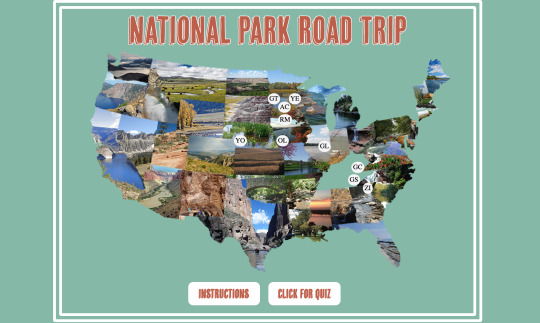
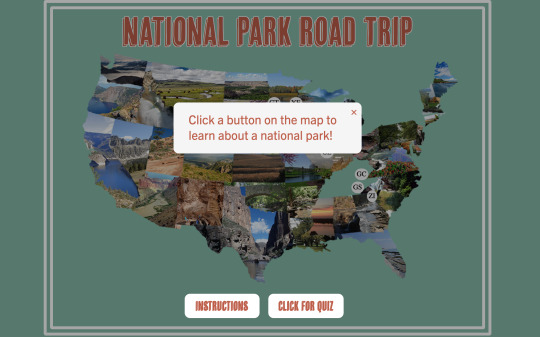
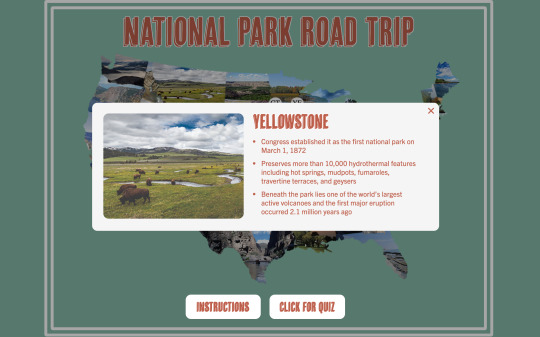

Final Coded Site

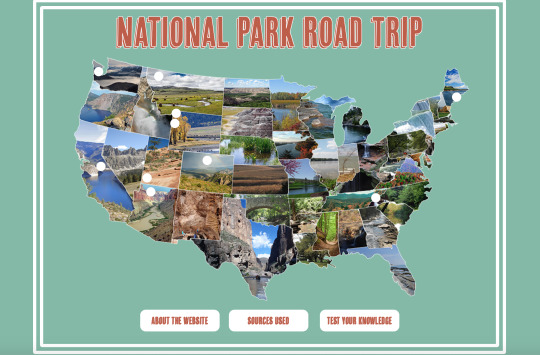

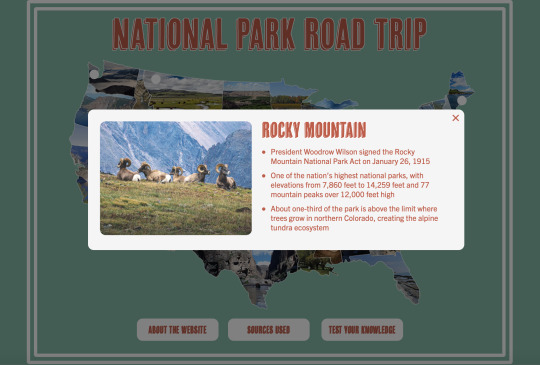

1 note
·
View note
Note
Here are my personal ideas.
Avatar: Liu Chonglin (12 December 1908-14 September 1999) was a Shanghai-based calligrapher who also wrote some poems and novels on the side. He was initially inspired to write the “Avatar” books when taking a road trip to the locations mentioned in “Journey to the West” in the middle of 1937, a journey which took him to Tibet and lead to him learning a lot about Buddhist culture and beliefs. He spent the next twenty-five years fleshing out a fully developed fictional universe before publishing the first of three books in 1962, followed by its sequel in 1964 and the final volume in 1966. The books weren’t massively successful on initial publication and weren’t even translated into English until 1987. However, there was a fondly remembered Taiwanese miniseries adaptation of just the first book in 1996. Bryan Konietzko first read the books on a road trip in 1997, and then he showed them to his friends Michael Dante diMartino and Aaron Ehasz and they all agreed this needed to be an animated series as soon as humanly possible. And the rest, as they say, is animation history.
In terms of adaptation, ATLA is…actually extremely close to its source material to the point where some fans of the book series see it as basically an animated audio book. Naturally, the author’s lengthy world-building tangents about everything from Water Tribe gift-giving customs to the architecture of Earth Kingdom cities to Fire Nation engineering practices to the very different conceptions of family and kinship amongst the Air Nomads to the life stories of various Avatars had to be slimmed down for the adaptation, but most of the iconic scenes everyone remembers (“Leaves from the Vine”, “That is a terrible experience, my friend”, “There is no war in Ba Sing Se”, “Everything changed when the Fire Nation attacked”) are lifted straight from the books. They also kept little details like Ty Lee’s Air Nomad ancestry and the Fire Nation being relatively egalitarian in terms of gender roles (fun fact: Azulon was originally an Army Officer who married Sozin’s granddaughter Ilah and was elected to the Fiery Throne after the death of his mother-in-law/Sozin’s eldest daughter Fire Lord Kasuga) and even went so far as to use Katara’s narration as a way of alluding to Liu Chonglin’s framing device of the book being a ‘translation’ of a biography Katara wrote about her beloved Aang after he died. Did I mention that this book had appendices and a lot of “Legend of Korra” was based on stuff mentioned in those appendices?
Amphibia: Matthew Lionel Joseph Strauss (03 September 1942-24 January 2019) was an American journalist and amateur herpetologist who lived for a large part of his life in Bangkok. He was famously livid about the lack of xenofiction stories about non-mammalian species, to the point where he eventually got fed up with “Yet another story about Voles” on 28 November 1987 and decided to write his own story about amphibians based on a bunch of poems he’d been writing for his children, students, and pets.
The big difference that’s immediately apparent to people who read the book “The Frog Lands: A Tale of Adventure” after seeing the TV show “Amphibia” is that the three main girls are all White and not working-class like they are in the show. Instead of being the daughter of two restaurant owners like Anne Boonchuy is in the show, Anne Parker in the book is the daughter of a wealthy family whose parents died in the Great Earthquake of 1906 (also, the book is set in 1908 San Francisco rather than in modern Los Angeles) and her uncle Edward Phineas Carrington is an evil occultist sorcerer determined to steal the Parker family fortune. When Anne and her friends Marcia Sanderson (here a foundling of possibly Sicilian descent raised in a Catholic orphanage but still obsessed with fantasy and fairy tales) and Alexander Francis Wayland (son of Ezekiel Sampson Wayland, the scheming solicitor who’s helping Uncle Edward steal the Parker family fortune) try to stop Uncle Edward from forging the signature of Anne’s father so he can filch the fortune, he casts a powerful spell that turns all three girls into amphibians (Anne into a frog and Alexander into a toad and Marcia into a newt) and banishes them to a realm where he assumes they will be miserable.
There’s also a lot more emphasis on Amphibian spirituality in the book, with the Frogs and Toads and Newts practising a dualistic religious faith centred around a Good Deity called the Guardian and an Evil Deity called the Night. Hop Pop and Sprig in particular are very devoted to this faith and pray to the Guardian regularly whenever they’re in trouble or need help.
Most shockingly to a show watcher, however, is that Andrias III…isn’t evil in the slightest degree. He legitimately is the Good King whose tragic murder at the hands of Captain Grime allows the Night to escape from its prison beneath Newttopia and start to take over all the worlds in existence. Marcia sacrifices herself to save Anne and banish Grime and Alexandra to the Human Realm…and then the Night possesses her body to use as a puppet for its conquest of the universes. Short version is that the Night eventually makes its way into San Francisco and devours Edward Phineas Carrington, Ezekiel Sampson Wayland, and King-Emperor Grime before, at last, Marcia reasserts control over her own body and then she and Alexandra and Anne use the Three Guardian Diamonds to banish the Night into the Land of Oblivion and restore peace to the Human Realm and to Amphibia. Everyone goes home, Anne gets adopted by her nice grandfather George Parker and grows up to become a tailor and marries Alexander, who ends up running a more ethical version of his eldritch abomination-devoured father’s lawyer business, and Marcia grows up to be an author (and yes, there is implied queer subtext between Marcia and Anne), and Sprig ends up as a beloved Mayor of Wartwood while Queen Olivia and her husband Prince Johan end up rebuilding Newttopia in memory of her brave, martyred uncle Andrias.
Matt Braly read “The Frog Lands: A Tale of Adventure” between 15 November 2004 and 10 December 2004, and he generally loved it, but felt it didn’t do enough with its implied class themes either in the land of Amphibia or on Earth and has been famously quoted as saying “I felt there had to be a better ending for this story than just turn-of-the-century White girl gets her rightful fortune back”. So he began writing an adaptation that would tweak and update these themes while still maintaining the truly fascinating aspects of Strauss’ world building. In the next fifteen years, he basically rewrote the entire story down to junking the evil uncle and lawyer entirely and replacing them with an emotional journey of self-discovery on the part of his reimagined characters.
The Owl House: Katherine Abigail Waterford-Copeland (23 February 1940-28 October 2018) was an Irish-American author who specialised in teaching the history of Medieval and Renaissance Italy at the University of Maine. She published her first novel, “The Silkworms of Florence”, in 1968. She wrote twenty-three novels across the course of her career, a number of which were co-written with her husband Samuel Copeland (21 January 1943-14 November 2016). Fun fact: Her 1978 short story “The Secret Yearbook”, was actually the basis for “Back to the Future”, though I don’t think we’re going to get any meetings between Eda and Doc Brown any time soon.
“The Glyph Witch: A Modern Fairy Tale” is the fifteenth of Copeland’s novels, published on 18 July 1996. In her diaries, Copeland writes about how the concept of the novel was inspired by a time she went to a Shakespeare Festival in Salem, Massachusetts in December of 1992. The main attraction of that festival was a double bill-feature of “Twelfth Night” and “The Tempest”, two of Copeland’s favourite Shakespeare plays.
“After the plays, I got to thinking about the similarities between Illyria and the Island of Setebos as imaginary never lands in which the main characters can work out their issues, and about how Prospero conquers this other land and colonises it as it’s Emperor and how he’s kind of seen as a villainous anti-heroic figure by both Jacobean audiences who mistrusted magic and modern audiences who mistrust colonialism. So I decided to wonder unto myself ‘What if Viola of Messalina had landed on that mystical island of Prospero’s instead of in Illyria and then she and Miranda fell in love with each other and they began plotting against Prospero together with the explicit intention of freeing Ariel and Caliban and all the other spirits of the island?”.
-K. A. Copeland
With that inspiration in mind, Copeland began writing down the story of the kind of heroine she herself had kind of been as a child. She actually took influence from a number of different sources while crafting her tale, including Russian, Norse, Celtic, and Native American myths and fairy tales, “The Neverending Story”, “David Copperfield”, the then-just-published “Northern Lights” and the myths of Orpheus and Perseus. And thus was born the Boiling Isles.
While not a major success upon it’s initial publication in America, “The Glyph Witch: A Modern Fairy Tale” was popular in Europe, so much so that a German TV studio actually produced and released a musical TV movie adaptation with wondrously bad special effects offset by some strong performances from the supporting cast. In 2004, Disney under Michael Eisner acquired the rights to Copeland’s original text and set out trying to adapt it into a feature film…or they would have if the company hadn’t shuttered its feature animation division not long afterwards. After that, the project sat on the shelf for several years until 2016, when a former dancer turned animator named Dana Terrace picked it up at a used bookstore and showed it to her friends Luz Batista and Alex Hirsch, who had a while earlier adapted Elaine Cornell’s 1988 children’s mystery novel “The Secret Shack in the Middle of the Woods” into the hit TV Series “Gravity Falls”. All three of them loved the book, but they felt certain aspects of it would be hard to adapt for a modern Disney Channel audience. They also had some clever ideas of their own they had always wanted to incorporate into a narrative, and so they decided to write a series bible that would flesh out the ideas they wanted to execute.
First big difference between the book "The Glyph Witch: A Modern Fairy Tale" and it's animated adaptation "The Owl House" is that, to start with, almost everybody in the book except for Eda and Lilith have different names than their show counterparts. Luz Noceda was named Jane Leland, her mother Camila was originally Jane's great-uncle Ambrose, Amity Blight was originally a boy named Abacus Brightglove, Willow Park was originally named Wilhelmina Griffith, Augustus "Gus" Porter was originally Augustine Lorenzo "Gusty" Delapoer (though he is Black in both versions), Emperor Belos was originally the High Queen Klarios Bellona Septentrion, Hunter the Golden Guard was originally Prince Lucumo Mavoris Septentrion, Principal Hieronymus Bump of Hexside School of Magic and Demonics was originally Headmaster Antoninus Aurelius von Eisenbauer of the Vanaken Academy of the Mystical Arts, King was originally Reginarius,
Hooty was originally a qreen bird tube thing called Baldassaro, and non-binary transmasculine icon Raine Whispers was
originally a cisgender male knight named Syr
Reynard de Brumont.
Speaking of Luz, you can forget most of what you know about the lovable ADHD oddball we know and adore from the show. Jane Leland in the book is a much colder, more cynical character who is closed off against the world because of a lifetime of trauma and woe.
See whereas Luz in the show seems to have had a mostly normal working class immigrant upbringing aside from her oddness, Jane in the book had a truly screwed up childhood. Her father Sebastian Leland was a veteran of World War Two who met and fell in love with an Italian Rromani woman named Francesca Graziani while he was serving in Italy. They managed to get married in a loose civil Union made possible by Francesca pretending to be White. Unfortunately, about two months after Jane’s birth on 20 October 1949, the secret was revealed to the town and Francesca was blamed for the kidnapping of a six-year-old boy named Billy Fenton and their house was burned down, with Sebastian and Francesca both dying in the flames and Sebastian’s younger brother Frederick sacrificing his own life to save his niece. After that, Jane was adopted by her grandfather Samuel Leland and his wife Agnes Peterson, who gave her all the love and affection that they could and helped her form her special interest in fantasy by reading her stuff like Tolkien and the Brothers Grimm. Unfortunately, Agnes succumbed to liver cancer on 17 November 1955 and then her husband Samuel died of stomach cancer on 26 October 1956. Because Samuel’s own father Thomas Victor Leland had been dead since 23 September 1940 and his mother Ellen Marie Franklin had been dead since 22 July 1942, the only family Jane had left in the world was her grandfather’s younger brother Ambrose.
Backstory changes aside, Camila and Ambrose are not that different in terms of personality. They’re both rather strict but extremely loving and warm parent figures who try their best to understand their children, though Ambrose is more strictly a classical Orthodox Jewish farmer than Camila. Though Camila is a nurse in the show and Samuel was a doctor, so Camila is basically a composite character.
It’s also worth discussing how the Lelands were originally Sephardic Jewish refugees from Catholic Spain who settled in Cork, Ireland after the Inquisition drove them from their homes in 1496 and stayed in Ireland until they left for Maine in 1849. Point is, both Jane and Luz are outsiders everywhere they go in the Human Realm, which is why they both bond so well with fellow outsiders like Eda, Reginarius/King, Baldassaro/Hooty, Mina/Willow, Gusty/Gus, and Abacus/Amity.
Abacus, meanwhile, is similar-ish to Amity aside from the gender, but there are some pretty meaningful differences. To begin with something minor but interesting, Edric and Emira were actually named Cedric Brightglove and Aemilia Brightglove in the book, and they were his cousins rather than siblings. They were also Ghost Characters who were mentioned a couple of times but never actually appeared. Instead, Jane found Abacus’ diary by accident while cleaning up shelves in the Bonesborough Library.
Another interesting thing about Abacus is that whereas Willow and Amity in the show were just best friends who drifted apart because of Amity’s parents being dicks, Abacus and Wilhelmina were straight up betrothed to be married in the book. However, Wilhelmina basically got too experimental with plant magic and…destroyed Odalia Brightglove’s beloved greenhouse before turning half of House Brightglove’s citadel into a tropical rainforest. Abacus tried to stand up for his friend, but Odalia rammed her walking stick into his right foot and left him with a scar and a limp.
Even after that, however, Abacus couldn’t bring himself to hate Wilhelmina and never so much actively persecuted her as he just hung out in the background while the bullying was happening. It wasn’t until after Jane beat Abacus in a duel that he started to realise how wrong his behaviour was. The dude was absolutely fierce once roused to protect people he cared about after that, to the point where it’s implied he might have helped Jane fend off Cursed!Eda in the aftermath of the duel.
And yes, a number of events in the show were rearranged or embellished from single paragraph mentions in the book And yes, a number of events in the show were
rearranged or embellished from single paragraph mentions in the book, most notably
"Understanding Willow", "Really Small Problems", and "Once upon a swap". Also,
the infamous incident where Jane/Luz almost
gets killed by a demon while trying to pursue a wish fulfilment fantasy quest was originally the first thing she did on the Boiling Isles. And unlike what the show did with the Squid Puppeteer, the book pulled no punches about Vanek Adagastos' desire to kill Jane, skin her alive, and use the best parts of her flesh to repair his own body. Jane fought back bravely, but was only saved from the Lightning Necromancer because Eda intervened to get back some potions he'd stolen from her a few days earlier. Damn, that's dark.
Eda in the book was quite harsh on Jane at first, excoriating her for getting herself in over her head and threatening to turn her into a maggot and have her for lunch before revealing her own personal veganism. Jane was actually invited to the Fortress of Lord Ira of House Rathbone because Eda and Reginarius needed a distraction. It wasn’t until Jane freed a bunch of prisoners from the Rathbone Citadel that Eda started to take her at all seriously.
Also, it was Eda who sent Jane to the Academy as a way they could lay low until the Rathbone Crisis blew itself over.
If you’ve ever wondered why the Imperial Coven never just slaughtered Eda and her Owl House family before the story started, well…One thing the book discusses more than the show ever does is just how much the Boiling Isles is a feudalistic society wherein a whole bunch of Witch aristocrats rule over all other Witches, while Demons and Monsters are firmly kept down as twelfth-class citizens. Eda and Lilith’s mother Gwendolyn was ruler of Bonesborough and made great efforts to conceal her daughter’s rebellious acts from the government. And because Lady Clawthorne was a talented Hypnotist, few people noticed she was doing it. Also, the Owl House of the book was firmly underground and the only way to get in or out was to let Baldassaro eat you or puke you back out, much to Abacus Brightglove’s complete and utter annoyance. Book!Eda was also very careful not to go outside the House unless she was in her falcon form, resulting in her tearing apart Adagastos with poison claws and lightning and fire from her eyes. Only reason she didn’t stay in falcon form for her battle with Lilith is because Lilith used a magic arrow that disrupted her ability to maintain that particular transformation.
By far the most interesting change, however, was to the character of the main antagonist. First off, ignoring the gender change, let’s talk about how, while the High Queen’s full name was indeed Klarios Bellona Septentrion, she was almost never referred to as Bellona. Usually she was Queen Klarios or Empress Klarios or Klarios Septentrion (Septentrion being an archaic term for “North” and referring to how her castle was built in the north of the Isles around the Titan’s Heart). And boy o boy, her book backstory was…a doozie.
See, in real life history, there was a thing wherein Lionel, Duke of Clarence, third son of Edward III of England, married Violante Visconti, daughter of one of the most ruthless and despotic dynasties in European history, in 1368…but died not long afterwards before he could consummate things with his thirteen-year-old bride.
The story explains to us how, during this marriage, Bernabo Visconti, uncle of Violante, deflowered Heloise Valmont, an illegitimate daughter of King Edward III who was twenty-two at the time. Heloise was disgraced and sent from court on trumped up charges of trying to poison the Duke of Milan, and died giving birth on 02 March 1369. The girl was adopted as a servant child by a very cruel aristocratic family in Rome called the Orsini, who abused her and exploited for labour. A big result of this is that when the girl (named Maddalena) began manifesting magical powers around her twelfth birthday, she convinced herself that these incredible gifts made her far more amazing and powerful and magnificent and godlike than those who abused and hurt her. So when she found a portal entranceway to the Boiling Isles (or Maspala, as they were known back in those days) on 22 November 1383, she wasted no time in going in. As it happened, two of the most powerful sorceresses on those Isles, Joharra Palmer and Liliantha Weatherby, were close allies and secret advisors to the Visconti and Plantagenet lineages, and happily took Madeleine under their wing when they learned what her true heritage was.
Taking on the new full name of Rachel Elizabeth Madeleine Palmer, the girl worked her way up the ranks of various Magical Universities and attracted an ever larger cabal of followers with her idea that Witches were a naturally superior race of being blessed by Cybele Herself to rule over all things. She cemented her rule by uniting the Houses and the Coven Guilds underneath the banner of a single cause and turning the low-key system of monster oppression already in existence on Maspala into a full-on tyrannical police state. By 1526, she had cemented her rule over the entirety of the Isles and took as her Chancellor Catalina de Castillon y Vasconcelos, scion of a long line of Spanish anti-Muslim and antisemitic religious fanatic knights and distant if highly indirect ancestor of the last Grand Inquisitor of Spain. In order to cement her reign of terror and cruelty over the entirety of the region, she took upon herself the name Klarios Bellona Septentrion, translating roughly to “The Bright War Goddess of the Seven Stars”, the Seven Stars being a constellation said to represent the Seven Titans who made the world in Boiling Isles mythology, while Catalina took on the name Alma Latona Valerian. Together, they built their capital of Aurgelmir underneath the Titan’s Heart and established a regime that lasted for 434 years (1526-1960).
So basically…in the books…the villain was kind of a dark parody of traditional Chosen One archetypes, ie a miserable, lonely orphan who discovers they have magical powers and goes to another world to discover how they can be used and meets a mentor figure who teaches them how to become awesome and gradually takes over the world with a small army of allies, friends, and colleagues. She was a meticulous deconstruction of an archetype that a certain infamous transphobe had not even begun to publish in prose form by the time this book came out! And on top of that, the supremacist aspect of her characterisation was so pronounced that it freaking drove her conflict with Jane. As soon as Empress Klarios learned that a child from Earth had begun to learn magic through cunning and effort rather than just being born with it, it offended Her Infernal Majesty immensely! Just the same raw, cold fury you get from that one song in “Hadestown” where Hades sings about Orpheus’ kiss starting a riot.
Chancellor Alma, on the other hand, was fascinated by Jane’s persistence and determination, and honestly felt like the girl would make a useful contribution to their world domination team…rather ironic because her relatives had been amongst the people who helped drive Jane’s ancestors out of Spain in the first place.
And yes, Alma was a Human Witch just like her master. Klarios Bellona Septentrion wouldn’t be caught dead allowing an imp like Kikimora to rise to a high position of power and glory in her imperium.
By far the most dramatically changed character, however, is Reynard de Brumont in terms of his conversion to Raine Whispers. Forget everything you know about the tiny non-binary musician who won all our hearts in “Eda’s Requiem”. Reynard de Brumont is eight feet tall and built like Henry VIII and is basically the jolliest, most lovable fellow in all of the Boiling Isles. Think of him as basically a nobler and more principled version of Robert Baratheon. They kept the blue-green hair and dark green eyes and putting on a facade to undermine the government from within, however. Dude was also like, crazy intelligent and could recite all sorts of facts about the history of the Isles at the drop of a crown. And unlike the show where it was a while before Raine and Luz formally met each other during the Day of Unity, Reynard met Jane as soon as he arrived at the Owl House and they hit it off almost immediately. Jane literally described Reynard as “the loving father I had always wanted but never, ever had”.
And here’s another personal favourite change of mine…THE CONSPIRACY!!!
So in the book, Klarios was indeed cursed with a Wasting Illness just like Belos in the show. However, hers was part of a plot.
See, Alexios Beldarius (the book’s version of Darius Deamonne) was her Prince Consort and father of her son Prince Lucumo Mavoris Septentrion, but he desired the throne for himself. So he had gotten together with Syr Adrian Vernworth, Madam Henrietta Cutburn, Lord Vitimir Razaris, and Madame Teressa Bryndagora under the backs of the more loyal Archons of the Great Covens (Syr Lykourgos Kunigides, Lord Osran Sangclair, Lord Mason Eckstein, and Syr Lilith Clawthorne) to poison her slowly without her knowledge with the intention of ultimately having Lucumo murdered in the Boiling Sea and then having Chancellor Alma framed for the crime so that they and they alone could dispose of all their enemies and rule over the Isles as a powerful and near-almighty Decarchy composed of themselves and various new Coven Archons. They tried to get Reynard de Brumont on their side at one point in time, but he rejected their offers and told them to go shove it.
As for Lucumo himself, he is mostly similar to Hunter, but he’s also Hunter crossed with Riku crossed with that self-flagellating Albino monk from “The Da Vinci Code”. Amusingly, he does dig his own grave in the book, but his doing so is part of a larger cycle of self-hatred and nihilism out of which he only even remotely begins to climb once he befriends Jane and her friends.
Seriously, Lucumo (the name is apparently derived from an old Etruscan word for “King”, namely one called “Lauchume”) may not have had quite as sad a backstory as Hunter did in the show, but it was still pretty sad. Dude was about one-hundred-and-ninety-eight years old in the novel and had lived pretty much his entire life in the shadow of his parents’ miserable, loveless, and highly murderous marriage to each other. He fetishised death as almost a god in and of itself and would often sleep in a coffin as a way of processing his own despair about mortality. He still tries to make his bedroom as silent as the grave even after he’s moved into the Owl House and is slowly becoming much happier than he previously was.
The Collector is loosely based on a briefly mentioned Angel character named Zachariel whom Klarios Bellona Septentrion mentions as having killed and drained of their essence in order to gain power, but otherwise the Collector is completely and utterly derived from nothing more than Dana Terrace’s own very fertile imagination.
See also, Vee. There is not one mention of everybody’s favourite basilisk child in the book. Not once. She mostly exists to be a replacement for a truly strange incident in the book wherein Great-Uncle Ambrose, desperate to find Jane’s whereabouts and worn out with grief about her loss, goes around Maine looking for her and kidnaps a young boy named Danny Pollock. Ambrose locks Danny in a shed, strings him up like a piñata, and repeatedly beats him up with a baseball bat until he confesses what he did to Jane. This goes on for an entire chapter until Ambrose finally realises that Danny genuinely has no idea what happened to Jane and Ambrose lets him go home and later on hears about people he doesn’t realise are Jane and Klarios being teleported to the middle of New York City and just happens to be right when he takes the train down to Manhattan and arrives just in time to see Klarios transform herself into a Giant Biscione and begin ravaging the city. Did I mention he tells all of this to Jane and that is how we learn all this?
Anyway, Abacus and the people from the Isles arrive in New York and see Biscione!Klarios rampaging through the city and after a giant battle in Central Park (Lucumo vs Alexios, Mina vs Teressa, Gusty vs Vernworth, Reginarius vs Vitimir Razaris, and Abacus vs Henrietta Cutburn) that occurs alongside Lilith vs Eckstein, Eda vs Kunigides, and Reynard vs Osran Sangclair is going on back in the Demon Realm, the killing of all the Coven Archons results in a severe loss of power for Klarios and then Jane stabs her with a Tibetan ritual knife that drains her of all of Zachariel’s power.
Now unable to do Magic, Klarios is infuriated and tries to kill Jane, being thwarted only when a taxi cab rams straight into her as she’s taunting Jane for teleporting away just as the cab was coming down the street.
Abacus rushes Jane to the hospital for treatment and she survives and they have a dramatic kiss in the lobby of the hospital before Eda comes back to return them to the Boiling Isles, now 100% Klarios Free, Clawthorne Guaranteed.
The Witches of the Isles finally realise that Magical Feudalism was a terrible idea and decide to elect Lilith and Reynard as heads of a Provisional Council designed to oversee the transition of their culture from Empire to Democracy. And then Uncle Ambrose goes to live with Jane and Eda and Abacus in the Owl House while Mina, Gusty, and Lucumo decide to stay in the Human Realm (specifically Paris for Mina and Lucumo and Boston for Gusty) and Reginarius is finally happy with knowing who he is (a Titan) and Baldassaro is happy with how he helped everyone grow and mature and the book ends with Jane Sophia Leland and Abacus Walter Brightglove going out to watch the stars together and seeing the fireworks celebrating Klarios’ downfall illuminate the sky like the universe’s most triumphant fireflies.
@disregardcanon @dachi-chan25 @cynicalclassicist @elphabaforpresidentofgallifrey @cwonicdepwession @cutetanuki-chan @theofficialkai517 @theplantarsdeservebetter @koshercosplay
Random Silly AU question, but What If… “Avatar: The Last Airbender”, “Gravity Falls”, “Amphibia”, and “The Owl House” were all based on books like other classic Disney movies and shows? I’m particularly fascinated by how the shows would have differed from their respective source material.
okay so, my thoughts are
Avatar- started as a comic series in the mid eighties. it kept getting rebooted and going in different directions, and it was always directed more towards adults. the big changes were 1. making it less sexist 2. making it cohesive 3. making it less culturally insensitive 4. giving it a single, good art style and 5. making it for kids
Amphibia- based on a very old british picture book (think contemporary with peter pan) about a white british girl who gets stuck in a world of frogs and makes a home there, but brings "civilized" british things with her. the amphibia series brings a lot of the aesthetics and some of the humor and worldbuilding, but uses it to make a statement against colonialism and taking away people's choices.
The Owl House- based on an american young adult series of novels that ran from the late nineties to the mid-aughts. it is in a vein VERY similar to animorphs. while far less openly queer than the adaptation, a close reading will find that it has just as many implications.
it started as a critique of oppressive religion, but had an abrupt shift post 9-11 to incorporate anti-war sentiments.
#Long post cw#The Owl House#Amphibia#Avatar: The Last Airbender#adaptation#albeit from imaginary books#spoilers cw#Fire cw#poison cw#caps cw#murder cw#Luz Noceda#Amity Blight#Hunter Wittebane#Willow Park#Gus Porter#Aang#Katara#Zuko#Iroh#Water Tribes#Earth Kingdom#Fire Nation#Air Nomads#Anne Boonchuy#Sasha Waybright#Marcy Wu#Sashannarcy#Lumity#Huntlow
13 notes
·
View notes
Photo

Los Angeles Zoo & Botanical Gardens is a 133-acre home to a range of animals, and is located in Griffith Park, one of our favorite places in all of California. In this LA Zoo review, we’ll share photos, cover the good and bad of the L.A. Zoo, how it compares to the San Diego Zoo, and more!
To be entirely honest, it took us a while to visit the LA Zoo. Even after living in California for several years and being members of the San Diego Zoo, we still hadn’t gone. This was despite living closer to the LA Zoo and visiting Griffith Park more times than I can count.
We just always had this perception of the LA Zoo–and I’m not even sure what it was based upon–that it was inferior and second rate as compared to the San Diego Zoo, so why bother? Well, we had that question answered for us when we finally visited the Los Angeles Zoo & Botanical Gardens and discovered that our preconceptions were pretty off-base…
Before we dig into the inevitable San Diego Zoo v. LA Zoo comparison, let’s begin with an overview and review of the Los Angeles Zoo…
Today, the Los Angeles Zoo is home to more than 1,400 mammals, birds, amphibians, and reptiles. These creatures represent more than 270 different species, including 58 that are endangered.
In addition, the LA Zoo’s botanical collection spans several planted gardens that contain over 800 different plant species and roughly 7,000 individual plants.
The City of Los Angeles owns and operates the LA Zoo, its land and facilities, and everything inside. The zoo opened in 1966, replacing the now-defunct Griffith Park Zoo, which is still in existence and home to more urban explorers than animals.
Current photos of the old Griffith Park Zoo circulate with regularity and wow what a difference a few decades makes it terms of zoological standards.
While there’s a stark contrast between today’s Los Angeles Zoo and the Griffith Park Zoo of 50+ years ago, the reality is that some areas of the current LA Zoo still feel like vestiges of the past.
While walking around, you can tell that some aspects of the zoo are a few decades old, but there have been plenty of modernization efforts to keep things looking–and feeling–fresh.
More importantly, the LA Zoo is clearly a modern zoo from the perspective of evolving beliefs about the humane treatment of animals.
The facilities appear, to us at least, to be humane and spacious for the creatures, and we saw nothing that raised any concerns about animal treatment.
Of course, we are hardly experts in this realm, but it’s worth noting that the Los Angeles Zoo is accredited by the Association of Zoos and Aquariums. I do know that the LA Zoo has done extensive work to aid in the recovery of California Condors.
In 1982, the zoo launched California Condor Recovery Program (CCRP), which then focused on building a captive breeding population. Now that the species has recovered, the LA Zoo assists with monitoring and maintaining the populations of wild condors that have been re-established in California.
One of the most engrossing exhibits is Campo Gorilla Reserve, which is home to six western lowland gorillas. Here you walk along a forested pathway for views of two separate troops of gorillas, a family and a bachelor group, living among waterfalls and lush plants.
The LA Zoo’s latest attraction is the Rainforest of the Americas. This exhibit features detailed sculptures, educational graphics, and architectural elements create an immersive experience for visitors, while animal highlights include piranhas, giant otters, harpy eagles, and cotton top tamarins.
Elephants of Asia is one of the LA Zoo’s main (and newer) draws. This exhibit is aimed at familiarizing visitors with the challenges Asian elephants face in the wild, including their shrinking natural habitat. This is an interesting and illuminating exhibit.
This Elephants of Asia tracks the history and culture of the animal through Cambodia, China, India, and Thailand. There are bathing pools, sandy hills, varied topography, and several different viewing areas offering varied perspectives into the exhibit.
Another favorite area of ours is Australia, which is home to the Zoo’s kangaroo and koalas. These marsupials are displayed in the Australia section of the L.A. Zoo.
This area is also home to the Australia Nocturnal House, which features a rare Southern hairy-nosed wombat, a species that can only be seen in four other Zoos in North America.
The koalas share two separate habitats with kangaroos, wallabies and echidnas. It’s cool to watch the baby koala and kangaroo joeys in this area.
Although tangential, I’d be remiss if I didn’t share one of my favorite stories about P-22, who is suspected in a “koala heist” at the LA Zoo a few years ago.
This was the area of the zoo where we spent most of our time, completely transfixed by those marsupials. With that said, we spent a lot of time at various areas throughout the zoo, finding a number of lower profile exhibits just as compelling as the big name ones we specifically list here.
Time flew by, and before we knew it, we had been at the LA Zoo for roughly 5 hours.
It’s tough to find much to criticize about the Los Angeles Zoo, especially for its relatively inexpensive admission fee. One thing we did notice was that none of the food looked even remotely worthwhile, but this is hardly unique to the LA Zoo.
We anticipated this, eating before arriving and again immediately after leaving. It’s Los Angeles–even with decent zoo food, you’re obviously going to do better dining at a real world restaurant.
The Los Angeles Zoo receives nearly 1.8 million visitors per year, making it one of the most popular attractions in Southern California. Thankfully, the sprawling complex and 100+ acre grounds make it good at absorbing crowds, but it still can get busy.
To avoid crowds, the best option is visiting right at opening on a weekday morning. Weekends are consistently the busiest time to visit, but weekdays can be bad if you choose poorly and visit on a day that multiple school groups have field trips to the LA Zoo. Visiting in the morning also offers the upside of seeing the most animal activity.
No matter when you visit, one of the big upsides to the Los Angeles Zoo is the lush grounds. Throughout the zoo, the pathways are frequently lined with mature trees that provide ample shade and a cool environment.
Likewise, many of the viewing areas offer shade and reprieves from the heat. This is a big deal on a hot day.
As for how the Los Angeles Zoo compares to the San Diego Zoo, the latter still reigns supreme. However, it’s a much closer call than you might expect, especially with the San Diego Zoo being world renowned and receiving all the accolades.
San Diego Zoo is superior thanks mostly to its “other stuff” like the aerial tramway, bus guided tours, and more. The wildlife lineup likewise gives it an edge, but not a pronounced one.
With that said, base 1-day tickets to San Diego Zoo cost nearly triple the price of those to Los Angeles Zoo. Quite simply, it’s not that much better than the LA Zoo. So, if money is an issue, we’d recommend the Los Angeles Zoo.
If money isn’t an issue, it probably comes down to whether you’re planning on visiting San Diego in addition to Los Angeles. (Arguably, the San Diego Zoo is not worth a special trip. The San Diego Safari Park, on the other hand…)
Overall, we were shocked by just how much we enjoyed our time at the Los Angeles Zoo and Botanical Gardens. It’s one of the best zoos we’ve visited, and while not quite on par with its formidable and far more famous counterpart in San Diego, it’s deserving of praise and tourist’s attention, too.
The Los Angeles Zoo is also conveniently located in Griffith Park, making it easy to spend the morning and midday at the zoo before heading Autry Museum of the American West for the afternoon, and then to Griffith Observatory for sunset and dusk (potentially even Hiking to the Hollywood Sign). That’s one great, jam-packed day in L.A., and all without having to fight any freeway traffic!
If you’re planning a trip, check out our Ultimate Guide to Los Angeles or our California category of posts. For even more things to do, The Best Things to Do in Los Angeles: 1001 Ideas is an exceptional resource, which is written by other locals. If you enjoyed this post, help spread the word by sharing it via social media. Thanks for reading!
Your Thoughts
Have you been to the Los Angeles Zoo and Botanical Gardens? If so, what did you think of experience? If you’ve been to both the LA Zoo and San Diego Zoo, how do you think they stack up to one another? Any additional tips to add that we didn’t cover? Would you visit the LA Zoo again, or do you think it was a ‘one and done’? Was it worth your time and money? Hearing feedback about your experiences is both interesting to us and helpful to other readers, so please share your thoughts below in the comments!.fca_eoi_form{ margin: auto; } .fca_eoi_form p { width: auto; } input{ max-width: 9999px; } .fca_eoi_form_input_element::-webkit-input-placeholder {opacity:0.6;color:;} .fca_eoi_form_input_element::-moz-placeholder {opacity:0.6;color:;} .fca_eoi_form_input_element:-ms-input-placeholder {opacity:0.6;color:;} .fca_eoi_form_input_element:-moz-placeholder {opacity:0.6;color:;} .fca_eoi_layout_3.fca_eoi_layout_postbox div.fca_eoi_layout_submit_button_wrapper:hover, .fca_eoi_layout_3.fca_eoi_layout_postbox div.fca_eoi_layout_submit_button_wrapper input:hover {background-color: !important;} .fca_eoi_layout_3.fca_eoi_layout_postbox {max-width:100%;} .fca_eoi_layout_3.fca_eoi_layout_postbox div.fca_eoi_layout_name_field_wrapper {max-width:49%;} .fca_eoi_layout_3.fca_eoi_layout_postbox div.fca_eoi_layout_email_field_wrapper {max-width:49%;} .fca_eoi_layout_3.fca_eoi_layout_postbox div.fca_eoi_layout_submit_button_wrapper {max-width:100%;}div.fca_eoi_form_text_element,input.fca_eoi_form_input_element,input.fca_eoi_form_button_element{display:block;margin:0;padding:0;line-height:normal;font-size:14px;letter-spacing:normal;word-spacing:normal;text-indent:0;text-shadow:none;text-decoration:none;text-transform:none;white-space:normal;width:inherit;height:inherit;background-image:none;border:none;border-radius:0;box-shadow:none;box-sizing:border-box;transition:none;outline:none;-webkit-transition:none;-webkit-appearance:none;-moz-appearance:none;color: Sans", sans-serif;font-weight:normal;transition:background 350ms linear;}div.fca_eoi_form_text_element{text-align:center;}div.fca_eoi_layout_headline_copy_wrapper{font-weight:bold;}div.fca_eoi_featherlight .featherlight-close-icon{background:rgba(255, 255, 255, 0);}div.fca_eoi_layout_3,form.fca_eoi_layout_3{display:inline-block;box-sizing:border-box;}div.fca_eoi_layout_3.fca_eoi_layout_widget div.fca_eoi_layout_field_wrapper,form.fca_eoi_layout_3.fca_eoi_layout_widget div.fca_eoi_layout_field_wrapper{width:100%;}div.fca_eoi_layout_3 .fca_eoi_progress,form.fca_eoi_layout_3 .fca_eoi_progress{margin-left:32px;margin-right:32px;height:24px;position:relative;background: 1px 2px 0 rgba(0, 0, 0, 0.5);margin-bottom:32px;}div.fca_eoi_layout_3 .fca_eoi_progress span,form.fca_eoi_layout_3 .fca_eoi_progress span{text-align:right;width:55%;display:block;height:100%;border-top-right-radius:3px;border-bottom-right-radius:3px;border-top-left-radius:3px;border-bottom-left-radius:3px;background-color: bottom, 37%, 69%);position:relative;overflow:hidden;}div.fca_eoi_layout_3 .fca_eoi_progress span:before,form.fca_eoi_layout_3 .fca_eoi_progress span:before{content:;position:absolute;top:0;left:0;bottom:0;right:0;background-image:linear-gradient(-45deg, rgba(255, 255, 255, .2) 25%, transparent 25%, transparent 50%, rgba(255, 255, 255, .2) 50%, rgba(255, 255, 255, .2) 75%, transparent 75%, transparent);z-index:1;background-size:50px 50px;animation:move 2s linear infinite;border-top-right-radius:8px;border-bottom-right-radius:8px;border-top-left-radius:20px;border-bottom-left-radius:20px;overflow:hidden;}div.fca_eoi_layout_3 .fca_eoi_progress span:after,form.fca_eoi_layout_3 .fca_eoi_progress span:after{content:50%;vertical-align:top;position:relative;top:5px;color:white;font-size:14px;line-height:14px;font-weight:bold;letter-spacing:1px;}div.fca_eoi_layout_3 img.fca_eoi_image,form.fca_eoi_layout_3 img.fca_eoi_image{max-width:100%;}div.fca_eoi_layout_3 div.fca_eoi_image_wrapper.placeholder,form.fca_eoi_layout_3 div.fca_eoi_image_wrapper.placeholder{text-align:center;white-space:pre;border:1px dashed div.fca_eoi_layout_content_wrapper,form.fca_eoi_layout_3 div.fca_eoi_layout_content_wrapper{margin:20px;}div.fca_eoi_layout_3 div.fca_eoi_layout_field_wrapper,form.fca_eoi_layout_3 div.fca_eoi_layout_field_wrapper{border:solid 1px transparent;border-radius:3px;margin-bottom:10px;position:relative;}div.fca_eoi_layout_3 div.fca_eoi_layout_name_field_wrapper,form.fca_eoi_layout_3 div.fca_eoi_layout_name_field_wrapper,div.fca_eoi_layout_3 div.fca_eoi_layout_email_field_wrapper,form.fca_eoi_layout_3 div.fca_eoi_layout_email_field_wrapper{width:100%;display:inline-block;}div.fca_eoi_layout_3 div.fca_eoi_layout_field_wrapper input,form.fca_eoi_layout_3 div.fca_eoi_layout_field_wrapper input,div.fca_eoi_layout_3 div.fca_eoi_layout_field_wrapper input:focus,form.fca_eoi_layout_3 div.fca_eoi_layout_field_wrapper input:focus{border:none !important;width:100%;height:auto;font-size:16px;line-height:1.2em;padding:7px 0;outline:none;background:none !important;box-shadow:none;}div.fca_eoi_layout_3 div.fca_eoi_layout_submit_button_wrapper,form.fca_eoi_layout_3 div.fca_eoi_layout_submit_button_wrapper{clear:both;transition:background 350ms linear, border-color 350ms linear;margin-left:auto;margin-right:auto;}div.fca_eoi_layout_3 div.fca_eoi_layout_fatcatapps_link_wrapper a,form.fca_eoi_layout_3 div.fca_eoi_layout_fatcatapps_link_wrapper a{display:block;margin:10px 0 0;font-size:12px;}div.fca_eoi_layout_3 div.fca_eoi_form_text_element ul,form.fca_eoi_layout_3 div.fca_eoi_form_text_element ul{list-style:inside;padding:0;margin:14px 0;}@media (min-width:1px) and (max-width:450px),(min-height:1px) and (max-height:450px){div.fca_eoi_layout_3 div.fca_eoi_layout_content_wrapper,form.fca_eoi_layout_3 div.fca_eoi_layout_content_wrapper{margin:8px 13px;}div.fca_eoi_layout_3 div.fca_eoi_layout_fatcatapps_link_wrapper a,form.fca_eoi_layout_3 div.fca_eoi_layout_fatcatapps_link_wrapper a{margin:0;}div.fca_eoi_layout_3 div.fca_eoi_form_text_element.fca_eoi_layout_headline_copy_wrapper,form.fca_eoi_layout_3 div.fca_eoi_form_text_element.fca_eoi_layout_headline_copy_wrapper{margin-bottom:5px;}}@media (min-width:1px) and (max-width:768px){div.fca_eoi_layout_3 div.fca_eoi_layout_field_wrapper,form.fca_eoi_layout_3 div.fca_eoi_layout_field_wrapper{width:100%;}}div.fca_eoi_layout_3 div.fca_eoi_layout_headline_copy_wrapper,form.fca_eoi_layout_3 div.fca_eoi_layout_headline_copy_wrapper{margin:-20px -20px 20px;}@media (min-width:1px) and (max-width:450px),(min-height:1px) and (max-height:450px){div.fca_eoi_layout_3 div.fca_eoi_layout_headline_copy_wrapper,form.fca_eoi_layout_3 div.fca_eoi_layout_headline_copy_wrapper{margin:-8px -13px 8px;}}div.fca_eoi_layout_3 div.fca_eoi_layout_headline_copy_wrapper div,form.fca_eoi_layout_3 div.fca_eoi_layout_headline_copy_wrapper div{padding:10px;}div.fca_eoi_layout_3.fca_eoi_layout_postbox div.fca_eoi_layout_field_inner,form.fca_eoi_layout_3.fca_eoi_layout_postbox div.fca_eoi_layout_field_inner,div.fca_eoi_layout_3.fca_eoi_layout_popup div.fca_eoi_layout_field_inner,form.fca_eoi_layout_3.fca_eoi_layout_popup div.fca_eoi_layout_field_inner{margin:0 30px 0 5px;}div.fca_eoi_layout_3.fca_eoi_layout_postbox div.fca_eoi_layout_field_wrapper i.fa,form.fca_eoi_layout_3.fca_eoi_layout_postbox div.fca_eoi_layout_field_wrapper i.fa,div.fca_eoi_layout_3.fca_eoi_layout_popup div.fca_eoi_layout_field_wrapper i.fa,form.fca_eoi_layout_3.fca_eoi_layout_popup div.fca_eoi_layout_field_wrapper i.fa{position:absolute;top:0;right:10px;height:50%;width:auto;transform:translateY(50%);-webkit-transform:translateY(50%);}div.fca_eoi_layout_3.fca_eoi_layout_postbox svg.fca_eoi_layout_headline_copy_triangle,form.fca_eoi_layout_3.fca_eoi_layout_postbox svg.fca_eoi_layout_headline_copy_triangle,div.fca_eoi_layout_3.fca_eoi_layout_popup svg.fca_eoi_layout_headline_copy_triangle,form.fca_eoi_layout_3.fca_eoi_layout_popup svg.fca_eoi_layout_headline_copy_triangle{display:none;}div.fca_eoi_layout_3.fca_eoi_layout_widget,form.fca_eoi_layout_3.fca_eoi_layout_widget{position:relative;}div.fca_eoi_layout_3.fca_eoi_layout_widget div.fca_eoi_layout_field_inner,form.fca_eoi_layout_3.fca_eoi_layout_widget div.fca_eoi_layout_field_inner{margin:0 5px 0 2em;}div.fca_eoi_layout_3.fca_eoi_layout_widget div.fca_eoi_layout_field_wrapper i.fa,form.fca_eoi_layout_3.fca_eoi_layout_widget div.fca_eoi_layout_field_wrapper i.fa{position:absolute;top:0;left:10px;height:50%;width:auto;transform:translateY(50%);-webkit-transform:translateY(50%);}div.fca_eoi_layout_3.fca_eoi_layout_widget div.fca_eoi_layout_headline_copy_wrapper,form.fca_eoi_layout_3.fca_eoi_layout_widget div.fca_eoi_layout_headline_copy_wrapper{margin-bottom:0;}div.fca_eoi_layout_3.fca_eoi_layout_widget svg.fca_eoi_layout_headline_copy_triangle,form.fca_eoi_layout_3.fca_eoi_layout_widget svg.fca_eoi_layout_headline_copy_triangle{position:absolute;left:0;width:100%;height:20px;}div.fca_eoi_layout_3.fca_eoi_layout_widget div.fca_eoi_layout_description_copy_wrapper,form.fca_eoi_layout_3.fca_eoi_layout_widget div.fca_eoi_layout_description_copy_wrapper{margin-top:40px;}@media (min-width:1px) and (max-width:450px),(min-height:1px) and (max-height:450px){div.fca_eoi_layout_3.fca_eoi_layout_widget svg.fca_eoi_layout_headline_copy_triangle,form.fca_eoi_layout_3.fca_eoi_layout_widget svg.fca_eoi_layout_headline_copy_triangle{height:10px;}div.fca_eoi_layout_3.fca_eoi_layout_widget div.fca_eoi_layout_description_copy_wrapper,form.fca_eoi_layout_3.fca_eoi_layout_widget div.fca_eoi_layout_description_copy_wrapper{margin-top:20px;}}div.fca_eoi_layout_3.fca_eoi_layout_widget div.fca_eoi_layout_inputs_wrapper,form.fca_eoi_layout_3.fca_eoi_layout_widget div.fca_eoi_layout_inputs_wrapper{margin-left:30px;}div.fca_eoi_layout_3.fca_eoi_layout_widget div.fca_eoi_layout_inputs_wrapper i.fa,form.fca_eoi_layout_3.fca_eoi_layout_widget div.fca_eoi_layout_inputs_wrapper i.fa{left:-25px;}div.fca_eoi_layout_3.fca_eoi_layout_widget div.fca_eoi_layout_field_inner,form.fca_eoi_layout_3.fca_eoi_layout_widget div.fca_eoi_layout_field_inner{margin-left:10px;margin-right:10px;}div.fca_eoi_layout_3 div.fca_eoi_layout_submit_button_wrapper,form.fca_eoi_layout_3 div.fca_eoi_layout_submit_button_wrapper{border-bottom:solid 4px transparent;border-radius:3px;padding:0 !important;text-align:center;width:100%;}div.fca_eoi_layout_3 div.fca_eoi_layout_submit_button_wrapper,form.fca_eoi_layout_3 div.fca_eoi_layout_submit_button_wrapper{border-bottom:solid 4px transparent;border-radius:3px;padding:0 !important;text-align:center;width:100%;}div.fca_eoi_layout_3 div.fca_eoi_layout_inputs_wrapper,form.fca_eoi_layout_3 div.fca_eoi_layout_inputs_wrapper{margin:20px 0;}@media (min-width:1px) and (max-width:450px),(min-height:1px) and (max-height:450px){div.fca_eoi_layout_3 div.fca_eoi_layout_inputs_wrapper,form.fca_eoi_layout_3 div.fca_eoi_layout_inputs_wrapper{margin:8px 0;}}div.fca_eoi_layout_3 div.fca_eoi_layout_field_wrapper,form.fca_eoi_layout_3 div.fca_eoi_layout_field_wrapper{border-radius:3px;background: div.fca_eoi_layout_submit_button_wrapper input,form.fca_eoi_layout_3 div.fca_eoi_layout_submit_button_wrapper input{background:none;border-radius:3px;border:0;padding:6px;width:100%;white-space:normal;}div.fca_eoi_layout_3 div.fca_eoi_layout_submit_button_wrapper input:hover,form.fca_eoi_layout_3 div.fca_eoi_layout_submit_button_wrapper input:hover{background:none;} .fca_eoi_layout_3.fca_eoi_layout_postbox { background-color: !important; } .fca_eoi_layout_3.fca_eoi_layout_postbox { border-color: !important; } .fca_eoi_layout_3.fca_eoi_layout_postbox div.fca_eoi_layout_headline_copy_wrapper div { font-size: 27px !important; } .fca_eoi_layout_3.fca_eoi_layout_postbox div.fca_eoi_layout_headline_copy_wrapper div { color: !important; } .fca_eoi_layout_3.fca_eoi_layout_postbox div.fca_eoi_layout_headline_copy_wrapper div { background-color: !important; } .fca_eoi_layout_3.fca_eoi_layout_postbox div.fca_eoi_layout_description_copy_wrapper p, .fca_eoi_layout_3.fca_eoi_layout_postbox div.fca_eoi_layout_description_copy_wrapper div { font-size: 15px !important; } .fca_eoi_layout_3.fca_eoi_layout_postbox div.fca_eoi_layout_description_copy_wrapper p, .fca_eoi_layout_3.fca_eoi_layout_postbox div.fca_eoi_layout_description_copy_wrapper div { color: !important; } .fca_eoi_layout_3.fca_eoi_layout_postbox div.fca_eoi_layout_name_field_wrapper, .fca_eoi_layout_3.fca_eoi_layout_postbox div.fca_eoi_layout_name_field_wrapper input, .fca_eoi_layout_3.fca_eoi_layout_postbox div.fca_eoi_layout_name_field_wrapper i.fa:before { font-size: 14px !important; } .fca_eoi_layout_3.fca_eoi_layout_postbox div.fca_eoi_layout_name_field_wrapper, .fca_eoi_layout_3.fca_eoi_layout_postbox div.fca_eoi_layout_name_field_wrapper input, .fca_eoi_layout_3.fca_eoi_layout_postbox div.fca_eoi_layout_name_field_wrapper i.fa:before { color: !important; } .fca_eoi_layout_3.fca_eoi_layout_postbox div.fca_eoi_layout_name_field_wrapper { border-color: !important; } .fca_eoi_layout_3.fca_eoi_layout_postbox div.fca_eoi_layout_email_field_wrapper, .fca_eoi_layout_3.fca_eoi_layout_postbox div.fca_eoi_layout_email_field_wrapper input, .fca_eoi_layout_3.fca_eoi_layout_postbox div.fca_eoi_layout_email_field_wrapper i.fa:before { font-size: 14px !important; } .fca_eoi_layout_3.fca_eoi_layout_postbox div.fca_eoi_layout_email_field_wrapper, .fca_eoi_layout_3.fca_eoi_layout_postbox div.fca_eoi_layout_email_field_wrapper input, .fca_eoi_layout_3.fca_eoi_layout_postbox div.fca_eoi_layout_email_field_wrapper i.fa:before { color: !important; } .fca_eoi_layout_3.fca_eoi_layout_postbox div.fca_eoi_layout_email_field_wrapper { border-color: !important; } .fca_eoi_layout_3.fca_eoi_layout_postbox div.fca_eoi_layout_submit_button_wrapper input { font-size: 16px !important; } .fca_eoi_layout_3.fca_eoi_layout_postbox div.fca_eoi_layout_submit_button_wrapper input { color: !important; } .fca_eoi_layout_3.fca_eoi_layout_postbox div.fca_eoi_layout_submit_button_wrapper input { background-color: !important; } .fca_eoi_layout_3.fca_eoi_layout_postbox div.fca_eoi_layout_submit_button_wrapper { background-color: !important; } .fca_eoi_layout_3.fca_eoi_layout_postbox div.fca_eoi_layout_privacy_copy_wrapper div { font-size: 13px !important; } .fca_eoi_layout_3.fca_eoi_layout_postbox div.fca_eoi_layout_privacy_copy_wrapper div { color: !important; }
101 Things to Do in Southern California
The eBook is 51 pages long, featuring 75 photos, and (obviously) 101 things to do in Southern California. If you want a copy of this totally free 101 Things to Do in Southern California eBook, all you need to do is subscribe to our newsletter and you will receive a link to download the eBook.
We respect your privacy.
The post Los Angeles Zoo Review, Info & Tips appeared first on Travel Caffeine.
#fca_eoi_form_4126#444444;}fca_eoi_form_4126#933b00#000;font-family:"Open#d8d8d8;border-radius:3px;box-shadow:1px#eab868;background-image:linear-gradient(center#2bc253#54f054#979797;font-size:12px;line-height:14px;color:979797;}div.fca_eoi_layout_3#fff;}div.fca_eoi_layout_3#ffffff#ec5c34
0 notes
Text
INGMAR BERGMAN’S ‘SAWDUST AND TINSEL’ “We’re both stuck, Anne–stuck like hell”
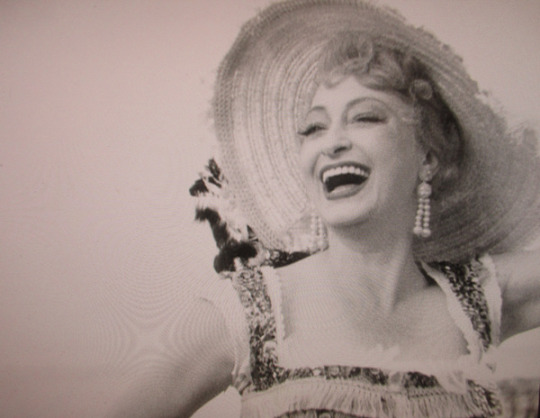
© 2019 by James Clark
Back in 2011, when (at Wonders in the Dark) I foolishly assumed that Ingmar Bergman was one of a small horde of filmmakers (including, Billy Wilder) after something very new, I was years away from comprehending what he had in store. Over the past year or so, I’ve wakened up a bit, to appreciate the momentousness of the range of his concerns, a range, despite good-will, leaving no impact where it really matters.
A constellation of conundrums of intent began to dawn upon me; and putting in place their dynamic has been quite a ride. But the elusiveness of the innovation has proven to be only slightly recognizable. Therefore, it’s time again to return to Sawdust and Tinsel (1953), which provides remarkable immediacy to those staying the course.
Whereas oracular figures—in Smiles of a Summer Night (1955), Winter Light(1963) and The Magician (1958)—would afford the thrill of seeing fit to trip up facile enforcement, the balance of power in the narratives remains so weighted against extreme change that understanding would almost absolutely trickle away. Similarly, the mea culpa, in Fanny and Alexander (1982), being brought to bear in terms of “the little world” (and its nagging spoiler, “the big world”), tends to be submerged by the Niagara of sturdy foibles. Then there is the perhaps too vague volcano of acrobatics and juggling, stemming from, The Seventh Seal (1957), and flashing over many subsequent entanglements the dark potency of which being lost on most viewers. The recherche dialogue between Eva and her muse, in Autumn Sonata (1978)—though a crucial clearing—becomes a victim of that protagonist’s hysterical self-importance. The action of silence (most salient in Persona [1966] but also on the move in, The Silence[1963] and Cries and Whispers [1972]), tends to be upstaged by the strong suit of survival. A mystical consummation, like that seen in, Wild Strawberries (1957), tends to maintain the status quo even more rigorously. Therefore, our second attention to this visceral production must be intent upon illuminating, as never before, the sensual structures and energies of players who live or die upon a cosmic scale.

One major expository response to that singular involvement is to spotlight two minor figures to lead the charge—the two stars of the show being brought to light as auxiliary weight for the previous marvels of poetic intensity. There is, of course, a saga, in this case pertaining to a slipping itinerant circus impresario and his slipping love life; but that’s not where the magic and the lift-off inheres. Careers and romantic complications are a dime a dozen; and they don’t tend to generate game-breakers.
Near the outset, a long-term carnie regales the rather recent owner, Albert, about an event of some rarity which happened 7 years before, involving a husband and wife team of clowns, still in the company. The troupe was set to entertain at a place along the seaboard, where an artillery regiment was engaged in training maneuvers. The flashback covering this crucial action has been given a medium of saturated sunlight in which to carry us on an even longer way from the mundane than killing fields and wandering sensationalism. “Tell the story if you want,” the boss allows (sitting on the driver’s bench of one of his caravans plodding along, early in the morning, drinking beer with the storyteller, and soon falling asleep, missing [as always] a remarkable revelation). “It was a hot summer day… The officers lay on the grass, hot and sweating, drinking out of boredom… Then along came Alma, an imposing woman… Carried herself like a queen, if a bit past her prime.” We see her, alone, on a ridge near the sea, bearing down upon the mere military, and carrying a basket for what might come along. Her dress of straight lines implies a mood not for curving away from her sterling desires. In fact, she is a vision of the goddess or medium, Aphrodite, she of coherent passion. As she approaches the fighting force, their cannonade becomes an imaginary orgy. Then, by way of an officer with cat whiskers in close-up yelling something where there is not a sound, except the cannon blasts, the recent workaday becomes even stranger. Cut to the brain-trust playing cards on the flat rocks. Advantage in the air. Cut to more of those silent mouthings, which disappear with a wave of sharp white space, soon displaying a division by way of the black uniforms. Alma merrily walks right over the improv poker table, spins around and produces an ironic smile and bow to her subjects. (The troopers on the ragged ground are not alert to their being overrun by a sworn enemy, as well as a congenial visitation to a lesser world. A soldier ridicules her, and she ridicules back.) Alma then begins to pull up her dress and challenge the power clique to live up to her powers. (In a cut, her advantageous mis-en-scene has been momentarily rescinded, to convey the human, often failing, interplay with the works of primary creativity.) The innuendo of coitus is taken up by the troopers and their shooting. Back on the topspin, Alma takes off her dress and tosses away her sun hat for the sake of a sunniness very seldom reached. (Such steps of hers like that will be repeated, somewhat, by that sleeping slug, unprepared for a crisis of cosmic proportions.)

Another stretch of fiery sky graces the beach; but disgrace looms, even during her ascendance to the ways of Aphrodite. Breaking the stalemate of mob ridicule and her wielding a secret weapon, an officer orders a cadet to go to her husband whereby more mundane resources would tip the scale and force a retreat. The apparition’s beloved clown and alcoholic, with infrequent rallies, lacks her ambition; and therewith we are to keep an eye on her miseries nearly buried by the ordinary two protagonists. And that Frost (where to start with that?—with Death, in the wings) rallies handsomely, though unevenly, that day. Never without his deathly white, cosmetic coloration (in glaring light he nearly disappears), his first appearance doesn’t seem much of anything. Brought out of the tent to meet the cadet, he mutters, “I once had the opportunity to perform for his Majesty…” [Frost being an exponent of trivial nostalgia in lieu of demanding traction]. (This is a gambit soon to re-emerge, in The Magician. As we work along here, we are impressed by how prepared this sojourn traces back to this film.) Only half-comprehending the dilemma, Frost misses the mark (as Albert will repeatedly miss the mark in the second part of that war-couplet which moves apace with great distinction): “The captain pays homage to me…” The cadet, who had conveyed that, “The captain sends his greetings,” sharpens up the message, to, “Your Alma is swimming naked with the regiment!” This causes his more realistic colleagues to laugh maliciously. A woman angrily confronts that drifter with, “Show you’re a real man! We’ll help you give her hell!” Someone else adds, “We’ll help you tar that saucy hide of hers!” With this, Frost pushes the sort of well-wishers away and rushes to the shore in a frenzy. Adding to his presence, are the pantaloons he always wears, trussed up in such a way that his physical proportions resemble an ostrich or a prehistoric bird. Frost being, in his eccentric and erratic way, also a primordial force, of questionable efficacy. With this crisis in the making, at a strategic point, we have our opportunity to regard this drama being very unlike others in its priorities. These presumed, by convention, also rans, are actually nearly the whole story. Their coming a cropper of the military devolves from the widespread war intrinsically bearing down upon creatures like our two clowns—too strange to readily stomach its stand in canniness; and too frail to mount a viable stand of uncanniness, going somewhere very few of humankind want to touch. Though cast as a problematic item of the preponderant in choices—a “circus and romantic saga”—in fact the action is devoted to a striking disclosure, beyond theatre and almost musical in its dynamic. The putative protagonists, Albert, and Anne, “lovers,” are the true also ran. They are trammeled with being not nearly crazy enough to be creatively balanced. And, therewith, the motif of the “little world” and the “big world” (explicit in Fanny and Alexander) hits the bricks to make of this entire Bergman filmic campaign, not a setting in relief of domestic exigencies but how the hell one might carve out a rhythm of sanity on a grotesque planet. As such, the entire (independent) corpus of Bergman’s endeavor must be seen as wall-to-wall war movies.
Frost, with the whole carnie nation delighting in his plight and racing close to his heels, encounters the mob of jeering heroes as he beholds Alma splashing offshore with an amphibian group. His shock, in close-up, is accompanied by a moment of all-out silence and stillness—as if the precinct of primal destruction clamps down for a moment. The white-out of the sun once again endows the chaos with pristine dignity. (Each of such stations emanating singular resources as to the massively ignored and dangerously beloved ways of life.) Then Frost calls out to her (no sound, no subtitles; but the cheesy, calliope circus theme). What was a regal bid to really live now begins to collapse. Jeering (now with the added non-strangers) recommences. Taking off his outer gear and struggling over jagged rocks provides another spew of black laughter. He does reach her, and those groping her drift away. In the capacity of a small but memorable rally, to consign to filmic archives, there is a close-up of him holding her and, as they behold the sea and the sky, they constitute an army of two. As that was transpiring, the cadet gathers up their clothes and hides them in a cravass. A girl from the circus laughs about that. Frost brings Alma to shore by having her on his back. The visual atmosphere is a slate sea and dark grey sky; and Frost, losing the energy to savor this austere beauty, begins to succumb to unsteadiness in negotiating the rocks while carrying her. Another silence obtrudes, as the couple resemble dying beasts. (The protagonists will prove to be all too human—predictable and presumptuous, leaving us more alerted to the fringes than the center.) The underestimated “clowns” are seen at a distance. The crowd closes in. Alma becomes stiff in his arms, her body like a cardboard sign. A deep drum roll sounds. The captain orders the heroes back to training. Frosts feet, shown in close-up, become very unsteady. That blazing outburst stages another fanfare to kindred spirits. A close-up finds them strangely glamorous at a watershed. Frost falls, and nearly faints. Another blinding brightness, another drum roll. They’re seen at a distance, on a ridge. (After such effort, this being a premonition of surrender, four years hence, in The Seventh Seal.) A feathery cloud formation becomes a confirmation that much had been well done. Then he falls, seen from afar. One more effort to proceed, and he’s flat on his face. He tries to crawl. (We’ll see Albert in a somewhat formally similar sequence, but with very little concern on the part of the cosmos.) Alma, no longer Aphrodite, fears for Frost’s life. Carnies and the cadet carry him home to the circus tent. Alma angrily (and silenced) reproves the wayward. She begins to cry out (silently covered).
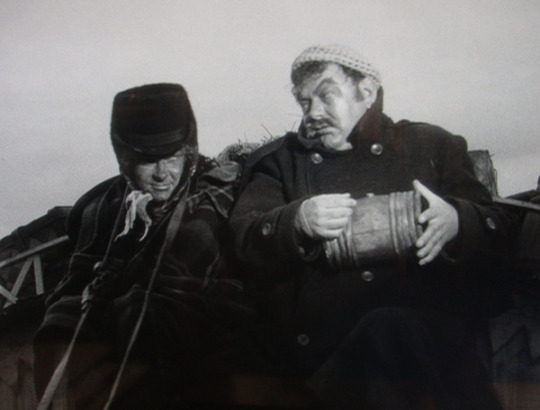
Back to the seat at the caravan emanating this strange event, with Albert, as always, missing in action. He and the driver jounce, due to the bad roads; they look like rather identical puppets. The driver concludes, “Alma began to shriek that we’d done her old man in. We got angry and told her it was her own fault. But we picked him up and carried him back anyway…”
The last sight of the two who rocked Sweden for a few hours, was Frost being carried by several men of the art of the body, as if he were a white caribou. His head is thrown back and the pan shot moves backwards, as if he’s the subject of a hunt already dead. Seven years beyond this oddity/ odyssey, the driver has rounded out his harangue with, “That’s a woman and love for you!” It is, of course, nothing of the sort, the eyewitness not having a clue of what had really taken place. Here’s the moment to introduce the virtually sterile protagonists, now running the show, very badly—by way of their phony business names: “Alberti” (as in, “Alberti Cirkus”); and, “a fiery Spanish rider astride an Andalusian thoroughbred,” being hopefully antidotes to mask their lack of lyricism, their lack of poetry, their lack of courage. The day we first see them together, they’re entering the town where Albert dragged his wife and two children (from a modest retail business) into showbiz as being, at last, his supposed reality. This venue, in contrast with the puppets and cold and fatigue on the first occasion, musters cinematography of beauty, in the form of a close-up of a wagon wheel moving over a bridge showing its reflection in the water, and an imposing windmill. A rooster crows. A dog barks a welcome. Forward motion in the air. But who’s up for what it takes?
The mid-20th century “fairground,” a scene of desolation itself, becomes the scene of the staff, many having seen far better days from far better management, announcing to the boss their displeasure in not having been paid for quite a while, with an outbreak of fleas in all the caravans, and lacking viable costumes. (During the hubbub Alma is aghast in hearing that one of her colleagues wants to have her pet bear [and vignette for her work] killed and eaten.) In response, we receive some idea of the details of Albert’s being unfit for bringing off viable imaginative work. He muses that in America there is a healthy market for circus activity. “In America, circus folk ride through town, while bands play and the elephants trumpet. Everyone puts on their biggest smile and people line the streets cheering. A booming voice announces the show for that evening…” The goofiness of that razzmatazz premise transplanting to rural Sweden, is part and parcel of the goofy business plan in Jacque Tati’s film, Jour de Fete (1949), where a French farm town mailman attempts to wow the citizenry with big-market, American systematics.
On the spot to at least seem to be a businessman, he proposes one of those effervescent, Jimmy Durante circus parades for the permafrost customers, only to be busted, the horses impounded on the grounds of failing to secure a permit. Albert’s other excellent idea—on stronger grounds, in view of the Swedish government lavishing tons of cash for the arts (the theatre building in this tank-town having been designed upon the model of the royal palace)—was to borrow some of the costumes of the rich store, in order to put on a memorable spectacle. But there is a significant more, bearing down upon this disarray, whereby Albert was to pay a visit to his former spouse and (formerly unhappy) former circus partner (now the successful lone tobacconist of the present scene). Sleepy Alberti’s career of running the show into near collapse has inadvertently alerted Anne, the non-Spaniard, at this window of opportunity, that he’ll be returning to retail and she’ll be needing to make very different plans than she had bargained for.

Albert and Anne constitute, however, not mere perverse dullards and fools, but rather facile, effete revolutionaries lacking the nerve to prepare for what their excitement involves. Each releases a mission statement in face of discouraging mainstream forces. Albert’s ex declares, “I’m happy now. It was always a time of frenzy and fear.” He counters with, “It’s always the same, summer and winter. For me, it’s emptiness.” Encountering rather feminine and arrogant Frans (an actor she meets during negotiations for the costumes; and perhaps her best bet if Albert bolts), she maintains that an earthy matier like the circus is the place to be. “I’ll bet you apply cosmetics. You have beautiful hands… You’re a weakling… You can’t [as he did] treat me like that or speak of my husband that way…” Frans pushes back, “If we were alone, I’d crush you. I’d crush your resistance like a piece of dirty paper.” She quickly attacks, “What play does that come from? Save it for your pale, flat-chested actresses…” Stirring declarations; but hollow. Anne does go in for “dirty paper.” And Albert proposes returning to the good old days. His wife had prefaced the little reunion with, “All I can offer is pancakes.”
The theatre personnel arrive late. And Frans, having been roundly insulted by Anne en route to a pancake tryst, feels entitled to trip up an inelegant entertainment. Although this very intense incident could be imagined to be (as with the battle on the shore could seem) a simple display of dispatching, by the powers that be, foolish, obsolete eccentricity—road kill—the membrane on tap copiously speaks otherwise, to the horror of so many who don’t care enough, and where that leaves those who do show audacity of sensibility reaching an astounding threshold. That the figures being tracked do not handle their audacity well, is beside the point of this reflection per se. Sawdust and Tinsel offers to us a conveyance inviting the viewer to behold emotion so raw that normal dimensions become shattered and thereby become an intimate challenge. By the time the caravan comes to the little town playing it safe, we notice Alma and Frost having abandoned the realm of Aphrodite in favor of variations of Aphrodite-Lite, the specialty of Albert and Anne. Frost and Albert clearly spend a lot of time getting drunk. Alma has her low-key bear; Anne has her Tarot cards. By the end of the saga, Albert is heard to lament, “We’re both stuck, Anne—stuck like hell…”

Whereas the insulting regiment, at the (double) beginning, never gets to be heard, Frans, showing off to a pretty actress in the troupe (where affluent, educated elites would have honed a range of useful skills), and with Anne astride her horse circling the sawdust stage, he calls out, “Feel alright after our adventure, Sweetheart?” This elicits from Albert, the ringmaster’s, whipping off of the show-offs straw hat. In one of those grand, dramatic ironies Bergman excels in, Albert’s shock and fury at that moment had landed him in depths of pain whereby he had put in his place the smooth cynic. Frans, not expecting lightning from such a source, experiences, almost uniquely, disarray. As he puts his hat on, the girl he brung laughs in his face. The supercilious small-town sensation had, remarkably, retreated. Were Albert truly conversant with squelching vain nobodies, his evening might have included modest rewards from which to invent circus theatre to surpass the sclerosis of the local artistes. But Albert, on a high and afraid of heights, repeats the fun—flashing his whip as if the smattering of Americana Conestoga covered wagons in the convoy endows automatic magic—and Frans, feeding on hate, smashes the pretender to a pulp.
Much about this bloody gore reminds us of Alma’s sunny day at the beach. Frans’ fighting skills (the Artistic Director of the big/ little theatre mired in lostness organizes the bad feelings in terms of a duel, which is to say, a stupid way to die and a stupid way to live) are a reprise of the artillery display which punctuated the ridicule of Alma. Albert’s baby-peal crying in pain, from a dirty trick directed at his balls, is a reprise of the fake crying of a clown in the first scene of the show, where Frost is now merely ordinary, wielding a ladder (going nowhere—not even funny) and squabbling with the crybaby. The townsfolks (including the ex), recalling the civilian population witnessing Alma’s abortive ascent, present a variation of the universal amusement—most enjoying the massacre, while a few being sickened by it. On the other hand—as with the conscripts to the nation—the theatre employees show 100% satisfaction, in their prissy way. Distributed about this maelstrom, we have Anne thrown from her horse, due to a guy in the last row throwing a missile hitting the thoroughbred; Alma’s gig with her bear totally washed out by the late-comers from civilization wandering across the ring (and, to worsen her latter days lot, yelling to hapless Albert, “That’s it, Albert!”); and the ringmaster both humiliated and on a roll of visceral courage, hopelessly misplaced.
At the end of the fight, Frost becomes a voice of the status quo: “Ladies and gentlemen, the show is over. Thank you for coming this evening…” Albert’s nightmare finds him in the role of an abused bear, in a bearpit. On gaining what he’d call consciousness, he grabs his pistol and shoots Alma’s bear. You could say, that was the last bit of integrity this company would see. But, for what it’s worth, the tug of creativity is hard to entirely kill.
The circus caravan is on the move later that night. Frost and Albert are walking along in crepuscular light and crepuscular mood. Albert maintains a depressive glare, never looking, nor, once again, listening to the outer limits of life itself. Frost, an artist to Albert’s merchandising, speaks up, with, “Yesterday afternoon I had a dream while I slept off the booze. I dreamt that Alma came to me and said, ‘Poor Frost, you look tired and sad. Wouldn’t you like to rest a while?’ Yes, I said. ‘I’ll make you small [smallness virulently in effect already] as a little unborn child. You can climb into my womb and sleep in peace.’ So I did as she said, and crept into her womb, and I slept there so soundly and peacefully, rocked to sleep as if in a cradle. Then I got smaller, until, at last, I was just a tiny seed, and then I was gone.” Frost had not gone much further than hysteria in that initial struggle. But his dream carried him to the frontiers of creativity, which is to say, a fresh start upon getting real, the precinct Alma inhabited when an instance of Aphrodite (which failed to find traction). Alma, from the cozy confines of their caravan bed, interrupts, “Stop trudging along out there! Come inside and sleep!” Frost, the alcoholic Everyman, explains to the bemusing navigator, “You see? She can’t sleep without me beside her!”

Here we come to an unexpected minefield. Do the fidelities, at this stage of the careers of the once-briefly brave, still reach the point of magic? Or do those gentle moves conceal a crime? The dream of starting again seems to tell us, “Yes.” Bergman, being one very, very tough dude, is not one to settle for sort of. Does his investigation (and that of a host of other investigators) leave room for leveraging the daily juggle where the daily acrobatics have startled? Sort of. But the film wants us to consider hostile armies that aren’t going away.
After Frost, the unfocused family man, goes to bed, Albert comes to a halt, and Anne (not needing to go to bed) has her moment of truth, which is something else from a moment of vision. (Along a trajectory of job-shopping with Frans in his dressing room and beyond, in the light of Albert bidding for a less American Dream, she doubles back, in memory, to catch Frans rehearsing a drama that could only avail as a purgative. “I am but a poor jester in this farce of dark shadows. Her deceitful heart, her frailty, even her taunting indifference, turn my world upside down every day and every hour…Art that Count Badrincourt of Chamballe, or the most miserable of wretches? Farewell, O world…May my tears water my poor grave…” The intruder that is Anne is positioned behind a damaged backdrop, and we see only part of her face breaking through the musty garbage in knowing to be something better. [Far from Aphrodite; but a physical key still in play].) There they are (Anne and Albert), in the dull light, now apprehensive. (While Albert was carried out of his sawdust bailiwick—a position repeating Frost’s unconsciousness after breaking down in aid of Alma—Anne was busy gauging Frans’ cheek. A few years later, in Hour of the Wolf [1968], a woman at a party gauges the cheek of an effete rebel, whose confused bid to manage there being no heaven costs his life.) Each manages a wan smile. And they walk along that pregnant roadway and its links coming close to the dance of death, about to be fully unveiled in The Seventh Seal. Our guide’s dramatic genius presents a disaster without recourse, while, on a wider front, things could improve.
0 notes
Text
Bufo
Bufo
This article is about toads. For the Finnish company, see Bufo (company). Bufo is a large genus of about 150 species of true toads in the amphibian family Bufonidae. Bufo is a Latin word for toad. Description True toads have in common stocky figures and short legs, which make them relatively poor jumpers. As with all members of the family Bufonidae, they lack a tail and teeth, and they have horizontal pupils. Their dry skin is thick and warty. Western toad (Bufo boreas) Behind their eyes, Bufo species have wart-like structures, the parotoid glands. These glands distinguish the true toads from all other tailless amphibians. They secrete a fatty, white poisonous substance which acts as a deterrent to predators. Ordinary, handling of toads is not dangerous, and does not cause warts in contradiction to folk beliefs. The poison of most if not all toads contains bufotoxin; the poison of the Colorado River toad (Bufo alvarius) is a potent hallucinogen containing 5-MeO-DMT and bufotenin. The poison's psychoactive effects are said to have been known to pre-Columbian Native Americans. Toads can also inflate their bodies when threatened. Males are usually smaller than females and possess a Bidder's organ, an incomplete ovary. The adult male of many species shows a dark throat. Breeding males have dark nuptial pads on their thumbs. Distribution This is a truly cosmopolitan genus, able to live under adverse conditions, and occurring around the world except in the Arctic and Antarctic, Madagascar, Australia (with the exception of the introduced cane toad), and New Guinea and Oceania. Two species are found in the British Isles: the common toad (Bufo bufo), and the natterjack toad, (Bufo calamita). The former is found almost everywhere in Great Britain, but not in Ireland. The natterjack, which differs in its shorter limbs with nearly free toes (which are so short, the toad never hops but proceeds in a running gait) and in usually possessing orange or red warts, green eyes, and a pale-yellow line along the middle of the back, is local in England, the south-west of Scotland, and the west of Ireland. It is further remarkable for the very loud croak of the males, produced by a large vocal bladder on the throat which, when inflated, is larger than the head. Psychoactive properties Several species of Bufo toads produce poison with psychoactive properties. The poison of one species (Bufo alvarius) contains both 5-MeO-DMT and bufotenin, while some others contain only bufotenin. Author Lee B. Croft, in his satiric novel, Toadies: The Explanation of Toxicomania in American Society, has coined the word "bufoglossation" to describe the deliberate licking of Bufo toads for hallucinogenic purposes, but psychoactive substance information site Erowid warns against such use because of the cardiotoxins (bufadienolides) included in the toads' poison. Groups Species in this genus can be quite different, which has led to a recent recommendation in the Bulletin of the American Museum of Natural History to split the genus, a recommendation that has been rejected (in part) by many taxonomists (see Pauly et al., 2004, Evolution 58: 2517–2535; Pauly et al., 2009, Herpetologica 65:115-128). Instead, the relationships between the different species are formalized by categorizing them into subgenera, such as Anaxyrus and Rhinella. Species Colorado River Toad (Bufo alvarius) Bufo is a large group, and it is usually divided into several subgenera. Frost et al. (2006) removed most of the species of former Bufo to other genera and restricted the name Bufo to members of the Bufo bufo group of earlier authors. However, other authors continue to recognize these subgroups of Bufo as subgenera. Rhinella is composed of a combination of Rhamphophryne and Chaunus (two subgroups of Bufo in the broad sense). Rhinella is recognized as a distinct genus by some, although other herpetologists disagree and maintain these species as a subgenus within Bufo. Here the species of Rhinella are treated in a separate page (where they may be considered a separate genus or as a subgenus of Bufo). Main article: Anaxyrus Some authors recognize the Genus, Anaxyrus, as a subgenus of the Genus, Bufo. Anaxyrus contains 22 species found in North and Central America including the common American toad, A. americanus. Composed of 12 species, this subgenus is found in temperate Eurasia and Japan south to North Africa, the Middle East, northeastern Myanmar, and northern Vietnam. Binomial name and author Common name Bufo aspinius (Yang, Liu, and Rao, 1996) Bufo bankorensis Barbour, 1908 Central Formosa toad, Bankor toad Bufo bufo (Linnaeus, 1758) Common toad, European toad Bufo gargarizans Cantor, 1842 Chusan Island toad, Asiatic toad Bufo japonicus Temminck and Schlegel, 1838 Japanese toad Bufo kabischi Herrmann and Kühnel, 1997 Bufo minshanicus Stejneger, 1926 Gansu toad, Minshan toad Bufo tibetanus Zarevskij, 1926 Tibetan toad Bufo torrenticola Matsui, 1976 Honshū toad, Japanese stream toad Bufo tuberculatus Zarevskij, 1926 Qinghai Lake toad, Round-warted toad Bufo verrucosissimus (Pallas, 1814) Caucasian toad Bufo wolongensis Herrmann & Kühnel, 1997 a fossil genus, Bufo linquensis lived during Miocene of China. This assemblage of 23 species remained outside the main groups. Frost et al. denoted the species in this group as polyphyletic by placing "Bufo" in quotation marks. Presumably, as these taxa are studied, they will be allocated to one or another of the existing groups. Binomial name and author Common name Bufo ailaoanus Kou, 1984 Ejia toad, Ailao toad Bufo arabicus Heyden, 1827 Arabian toad Bufo beddomii Günther, 1876 Beddome's toad Bufo brevirostris Rao, 1937 Kempholey toad, Short-nosed toad, Rao's pale brown toad Bufo cryptotympanicus Liu & Hu, 1962 Earless toad Bufo dhufarensis Parker, 1931 Oman toad - very similar to B. scorteccii Bufo dodsoni Boulenger, 1895 Dodson's toad Bufo hololius Günther, 1876 Malabar toad, Gûnther's toad Bufo koynayensis Soman, 1963 Humbali Village toad, Koyna toad, Chrome-yellow toad Bufo mauritanicus Schlegel, 1841 Berber toad, Pantherine toad, Moroccan toad Bufo olivaceus Blanford, 1874 Olive toad, Baluchistan coastal toad, Makran toad Bufo pageoti Bourret, 1937 Tonkin toad Bufo parietalis (Boulenger, 1882) Indian toad, Ridged toad, Timber forest toad Bufo pentoni Anderson, 1893 Shaata Gardens toad, Penton's toad Bufo scaber Schneider, 1799 Ferguson’s toad Bufo scorteccii Balletto & Cherchi, 1970 Scortecci’s toad Bufo silentvalleyensis Pillai, 1981 Silent Valley toad, South Indian hill toad Bufo stejnegeri Schmidt, 1931 Stejneger's toad, Korean toad, Water toad Bufo stomaticus Lütken, 1864 Assam toad, Indus Valley toad, Marbled toad Bufo stuarti Smith, 1929 Stuart’s toad Bufo sumatranus Peters, 1871 Sumatra toad Bufo tihamicus Balletto & Cherchi, 1973 Balletto's toad Bufo valhallae Meade-Waldo, 1909 Pulo Weh toad These four species were removed from the synonymy of Bufo by Frost et al., 2006. Smith and Chiszar, 2006, implied this taxon should be considered a subgenus of Bufo. They are found in South America. Binomial name and author Common name Bufo apolobambicus De la Riva, Ninon Ríos, and Aparicio, 2005 Bufo cophotis Boulenger, 1900 Paramo toad Bufo corynetes Duellman and Ochoa-M., 1991 Abra Malaga toad Bufo variegatus (Günther, 1870) Eden Harbour toad Containing 33 species, Frost et al. moved these members to a separate genus in 2006, first to Cranopsis, then to Ollotis, and then to Incilius. Binomial name and author Common name Bufo alvarius Girard in Baird, 1859 Colorado River toad Bufo aucoinae O'Neill & Mendelson, 2004 Bufo bocourti Brocchi, 1877 Bocourt's toad Bufo campbelli Mendelson, 1994 Campbell's forest toad Bufo canaliferus Cope, 1877 Dwarf toad Bufo cavifrons Firschein, 1950 Mountain toad Bufo coccifer Cope, 1866 Southern round-gland toad Bufo coniferus Cope, 1862 Evergreen toad Bufo cristatus Wiegmann, 1833 Large-crested toad Bufo cycladen Lynch & Smith, 1966 Northern round-gland toad Bufo fastidiosus (Cope, 1875) Pico Blanco toad Bufo gemmifer Taylor, 1940 Jeweled toad Bufo holdridgei Taylor, 1952 Holdridge's toad Bufo ibarrai Stuart, 1954 Jalapa toad Bufo intermedius Günther, 1858 Gunther's tropical toad Bufo leucomyos McCranie & Wilson, 2000 Bufo luetkenii Boulenger, 1891 Yellow toad Bufo macrocristatus Firschein & Smith, 1957 Large-crested toad Bufo marmoreus Wiegmann, 1833 Marbled toad Bufo mazatlanensis Taylor, 1940 Sinaloa toad Bufo melanochlorus Cope, 1877 Dark green toad Bufo nebulifer Girard, 1854 Gulf Coast toad Bufo occidentalis Camerano, 1879 Pine toad Bufo periglenes Savage, 1967 Monte Verde golden toad Bufo peripatetes Savage, 1972 Almirante Trail toad Bufo perplexus Taylor, 1943 confusing toad Bufo pisinnus Mendelson, Williams, Sheil & Mulcahy, 2005 Bufo porteri Mendelson, Williams, Sheil & Mulcahy, 2005 Bufo signifer Mendelson, Williams, Sheil & Mulcahy, 2005 Bufo spiculatus Mendelson, 1997 Bufo tacanensis Smith, 1952 Volcan Tacana coad Bufo tutelarius Mendelson, 1997 Bufo valliceps Wiegmann, 1833 These 11 species are distributed in the Greater Antilles. Binomial name and author Common name Bufo cataulaciceps Schwartz, 1959 Schwartz's Caribbean toad Bufo empusus (Cope, 1862) Cope's Caribbean toad, Cuban toad Bufo fluviaticus Schwartz, 1972 Dominican Caribbean toad Bufo fractus Schwartz, 1972 Bufo fustiger Schwartz, 1960 Bufo guentheri Cochran, 1941 Gunther's Caribbean toad Bufo gundlachi Ruibal, 1959 Gundlach's Caribbean toad Bufo lemur (Cope, 1869) Lowland Caribbean toad Bufo longinasus Stejneger, 1905 Stejneger's Caribbean toad Bufo peltocephalus Tschudi, 1838 Tschudi's Caribbean toad Bufo taladai Schwartz, 1960 Cuban Caribbean toad These two species were redelimited and removed from the synonymy of Bufo by Frost et al., 2006. Others implied this taxon should be considered a subgenus of Bufo. Binomial name and author Common name Bufo asper Gravenhorst, 1829 Malayan giant toad Bufo juxtasper Inger, 1964 Giant river toad, Borneo river toad Frost et al. moved these 10 species in 2006 to a separate genus. Binomial name and author Common name Bufo beiranus Loveridge, 1932 Beira's toad Bufo damaranus Mertens, 1954 Bufo dombensis Bocage, 1895 Dombe toad Bufo fenoulheti Hewitt & Methuen, 1912 Transvaal dwarf toad Bufo grandisonae Poynton & Haacke, 1993 Mossamedes toad, Grandison's toad Bufo hoeschi Ahl, 1934 Okahandja toad, Hoesch's toad Bufo kavangensis Poynton & Broadley, 1988 Khwai River toad, Kavanga toad Bufo lughensis Loveridge, 1932 Lugh toad Bufo parkeri Loveridge, 1932 Parker's toad Bufo vertebralis Smith, 1848 African dwarf toad, pygmy toad Frost et al. moved Bufo calamita Laurenti, 1768, Natterjack toad, in 2006 to a separate genus; it is found in Europe. Frost et al. moved these 15 species in 2006 to a separate genus. It is the B. viridis group of previous authors. Binomial name and author Common name Bufo balearicus Boettger, 1880 Bufo baturae Stoeck, Schmid, Steinlein & Grosse, 1999 Batura toad Bufo boulengeri Lataste, 1879 Bufo brongersmai Hoogmoed, 1972 Tiznit toad Bufo latastii Boulenger, 1882 Ladakh toad, Lataste's toad Bufo luristanicus Schmidt, 1952 Bufo oblongus Nikolskii, 1896 Danata toad, Middle Asiatic toad Bufo pewzowi Bedriaga, 1898 Bufo pseudoraddei Mertens, 1971 Swat green toad Bufo raddei Strauch, 1876 Tengger Desert toad, Radde's toad Bufo siculus Stoeck, Sicilia, et al. 2008 Sicilian green toad Bufo surdus Boulenger, 1891 Pakistan toad, Iranian toad Bufo turanensis Hemmer, Schmidtler & Böhme, 1978 Bufo variabilis Pallas, 1769 Bufo viridis Laurenti, 1768 European green toad Bufo zamdaensis Fei, Ye, and Huang in Fei, Ye, Huang & Chen, 1999 Bufo zugmayeri Eiselt & Schmidtler, 1973 These eight species were redelimited and removed from the synonymy of Bufo by Frost et al., 2006. Others implied this taxon should be considered a subgenus of Bufo. Binomial name and author Common name Bufo anderssoni Melin, 1941 Andersson's toad Bufo blombergi Myers & Funkhouser, 1951 Colombian giant toad, Blomberg's toad Bufo caeruleostictus Günther, 1859 Bufo glaberrimus Günther, 1869 Cundinamarca toad Bufo guttatus Schneider, 1799 Spotted toad, smooth-sided toad Bufo haematiticus Cope, 1862 Truando toad Bufo hypomelas Boulenger, 1913 Choco toad Bufo nasicus Werner, 1903 Werner's toad These five species are the former B. angusticeps group of Tandy and Keith, 1972, placed by Frost et al. in a separate genus. Binomial name and author Common name Bufo amatolicus Hewitt, 1925 Amatola toad Bufo angusticeps Smith, 1848 Sand toad, Common Cape toad Bufo gariepensis Smith, 1848 Karroo toad, Gariep toad Bufo inyangae Poynton, 1963 Inyanga toad Bufo robinsoni Branch & Braacke, 1996 Paradise toad source - Wikipedia Dear friends, if you liked our post, please do not forget to share and comment like this. If you want to share your information with us, please send us your post with your name and photo at [email protected]. We will publish your post with your name and photo. thanks for joining us www.rbbox.in
from Blogger https://ift.tt/2ubNGm7
0 notes
Text
How Beauty Drives Evolution
New Post has been published on http://ourplanetary.com/how-beauty-drives-evolution/
How Beauty Drives Evolution
“Survival of the Fittest.” Although Darwin failed to come up with that word, it has come to define his principle of evolution: that traits that improve a species’ odds of staying alive are particularly favored to be handed on. (Consider the Galápagos finches, whose beaks have changed over time to crack open one of a kind types of seeds.) But in The Evolution of Beauty, ornithologist Richard O. Prum argues that superficial dreams play a role as properly.
Beauty Drives
Take, as an example, the male membership-winged manakin, a hen whose ornate feathers have developed to supply a “song” at the same time as they fly (thanks to a sequence of bumps that vibrate inside the wind) that draws women. Far from making them more fit, those feathers — and the bigger bones required to help them — surely gradual the manakins down, suggesting that, as Prum concludes, animal splendor standards “may be as irrational, unpredictable and dynamic” as our own.
Hello From Ontario – A Driving Tour Along the Niagara Escarpment Although I love the metropolis the summer usually makes me itch to get out into the USA. So I knew as up my friend Karel with whom I had helped organize a convention a few years ago and requested him if he could mind getting together in his neck of the woods close to Burlington for a country using a tour of the Niagara Escarpment. Since we had now not seen every other for more than one years it turned into an extremely good opportunity to trap up and enjoy a stunning power on the same time.
So we met this morning on a car parking zone just off Guelph Line within the north give up of Burlington. I parked my car and off we drove in Karel’s convertible. We drove north into the green nation-state and up a slope to get to our first destination: a nature vicinity called the Mount Nemo Conservation Area. We parked the automobile and walked about 15 minutes eastwards through a woodland till we reached a steep cliff and a lookout factor that supplied a lovely a hundred and eighty diploma view over the rolling farm u. S . That became sprawling some distance beneath us.
The Niagara Escarpment is a geological formation that extends from western New York State through Ontario to Michigan, Wisconsin, and Illinois. It originated due to unequal erosion wherein a top layer of harder and more resistant dolomitic limestone overlays more without difficulty eroded shale. The slow erosion of the shale leaves at the back of cliffs of resistant cap rock. The limestone itself stems from a historical tropical sea and includes a number of the most amazing fossils of the Ordovician-Silurian geological technology.
Beauty Tips
In Ontario, the Niagara Escarpment functions the Bruce Trail: Canada’s oldest and longest footpath that extends over 800 km (with aspect trails) from Niagara Falls within the South to Tobermory inside the north. The whole vicinity has been unique a UNESCO World Biosphere Reserve due to its particular fauna and plant life. The Bruce Trail itself is marked by way of white blazes (white markings about 8 cm excessive and 3 cm wide) and is maintained by the Bruce Trail Association whilst aspect trails are marked with blue blazes.
One of the Niagara Escarpments distinguishing capabilities are the many lookout factors at the rocky outcroppings over an otherwise as an alternative flat location. In addition, the Niagara Escarpment has dozens of waterfalls wherein streams and rivers tumble over the limestone cliffs. The most well-known of those waterfalls is of route Niagara Falls which is also accessible on a facet trail from the Bruce Trail.
The Niagara Escarpment’s particular natural environment consists of many bird species (some of them endangered) along with the Bald Eagle, the Red-Shouldered Hawk, the Black Tern and the Hooded Warbler. Rare reptiles and amphibians also stay in the region, for instance, the Eastern Massasauga Rattlesnake and the North Dusky Salamander. 37 species of orchids have been observed within the northern components of the Escarpment, along with the Calypso Orchid, the Ram’s-head Lady Slipper and Alaska Rein Orchid. Considering that approximately 7 million people live within close proximity the organic range on this specific location is remarkable.
We started out walking on a trail right at the threshold of a cliff and Karel knowledgeable me that the Niagara Escarpment is extraordinarily popular with rock climbers. I wanted to take a good photo of the cliffs and crevices, however, my fear of heights and the shear vertical drop avoided me from exploring the very edge of the cliff. The many caves also are famous with spelunkers. We walked about 20 minutes northwards and had a beautiful view toward Rattlesnake Point, every other rocky outcrop along the Niagara Escarpment. Then we took an aspect path returned via the forest to the automobile parking space and continued our drive.
About ten mins further north we stopped at the village of Lowville to have a take a look at Lowville Park. The Sixteen Mile Creek slowly meanders via the park and nature trails department off from the parking lot vicinity. Right subsequent to the park is the Lowville Bistro, a lately renovated restaurant that gives upscale informal eating, a licensed out of doors patio, an ice cream parlor and take-out. The city itself dates back to the early 1800s and was advanced after the Mississauga Land Purchase. The descendants of a number of those early settlers nonetheless live in the village today. 36 historical buildings and a Pioneer Cemetery still undergo witness to this as soon as a thriving rural community.
Leaving Lowville behind we headed directly north to any other conservation region inside the Halton Region Conservation System: Crawford Lake features a so-called meromictic lake, a deep frame of water where distinct layers of water do no longer intermix. This creates an oxygen-poor surroundings that aren’t conducive to dwelling organisms. As an end result, archeologists are capable of drill center samples of soil from the lake mattress that date again several centuries. One of those drillings caused the invention of corn pollen and the realization that there has been as soon as an Indian village within the region. Subsequent archeological digs showed the presence of a native settlement.
A fifteenth century pre-touch Iroquoian Village has been reconstructed on its original website and capabilities timber longhouses that comprise sound asleep quarters, a fire pit and garage areas for equipment, animal hides, and meals. Guides offer motives of the lifestyle of the Iroquois tribes that inhabited this area. This conservation vicinity is a famous vacation spot for faculty children and summer season camps and throughout our go to numerous groups of young people have been taking part in themselves inside the grassy regions in front of the lengthy homes.
Evolution vs Creation
The Niagara Escarpment is simply complete of blanketed nature areas, and just 10 mins north of the village of Campbellville is any other nature place: the Hilton Falls Conservation Area features first-rate trekking, mountain cycling, and move-u. S . A . Ski trails in the place. More than 30 km of forest trails weave their manner around the Hilton Falls Reservoir and a 10-metre high waterfall cascade over the Niagara Escarpment. Across the road from Hilton Falls is the Kelso / Glen Eden Conservation Area whose highlights consist of a sandy seashore in addition to 22 kilometers of trails for mountain bikers and 12 slopes for downhill skiers.
We persevered our pressure south to the Town of Milton, which consistent with the 2006 Census, is the quickest growing network in Canada. The population of Milton has grown by means of more than 70% between 2001 and 2006 and stands approximately 56,000 humans now. Milton dates lower back to the 1820s when English settlers Jasper Martin and his spouse Sarah had been granted 100 acres of land from the Crown.
Martin built a grist mill alongside Sixteen Mile Creek and also created a pond, Mill Pond, which continues to be in lifestyles nowadays and has to emerge as a popular pastime place for nearby citizens with its taking walks trails and the gazebo that overlooks the water.
Main Street in downtown Milton still speaks of its Victorian historical past, vintage City Hall, the Post Office Building and numerous other church buildings and secular homes date lower back to the mid to late 1800s. Many restaurants and cafés have sprung up in the downtown center which beckons traffic to sit down and loosen up on a number of their outside patios.
From the quaint town of Milton, we headed northwest in the direction of a small village called Aberfoyle, north of Highway 401. Karel cautioned that we’ve launched at the neighborhood Aberfoyle Mill, an actual mill that becomes converted into a restaurant in 1966. Aberfoyle itself became first settled within the 1840s and is famous for its Aberfoyle Spring Water.
The Aberfoyle Mill itself become constructed with the aid of a Scottish immigrant by means of the call of George McLean in 1859 and even won a gold medal for its oatmeal at the 1867 World’s Fair in Pairs. After stopping operations within the late Twenties the mill became bought with the aid of the Owens own family in 1960 who then spent six years renovating it and turning it into one of the most particular country restaurants in Canada.
Australia’s Great Ocean Road lies in Victoria and changed into constructed among 1919 and 1932. The road is dedicated to the Australian squaddies who died inside the First World War. The development of the 285 km lengthy road gave employment to the squaddies who returned from the war and to the those who have become unemployed during the Great Depression that accompanied.
Stunning perspectives In spite of the closely forested and mountainous place, the Great Ocean Road has been manually dug up alongside the curved coastline between Torquay and Warrnambool, leaving steep cliffs to one side one the street and really slender parts. Fortunately, there are masses of spots where you may stop to experience the beautiful perspectives.
Endless Coastline It’s a beautiful force, particularly wherein the street follows the shoreline through the forests of the Otway National Park, the coastal fringe of Angahook-Lorne State Park and the entire length of Port Campbell National Park. Don’t pass over out on Lake Corangamite and the Princess Margaret Rose Caves.
The Shipwreck Coast The Great Ocean Road runs alongside the coastline for quite a protracted stretch. Port Campbell National Park is a part of this impressive stretch and also referred to as Shipwreck Coast, named after the at least eighty ships which crashed alongside the rugged shoreline.
Twelve Apostles Near Port Campbell, twelve famous sea stacks get up from the ocean: the Twelve Apostles. These dramatic rock formations wherein fashioned via high winds and large waves as a result of violent storms. The Twelve Apostles were once part of the limestone cliffs alongside the coastline. Through millennia of erosion, they now stand proudly on my own in the ocean.
0 notes
Text
Frogs, newts, and toads
Researchers in America have been looking into the effects of climate change on fifteen amphibian species.
Climate change predictions across the world suggest that temperatures will go hot and cold for some time, but ultimately the planet is becoming warmer. Frogs, newts and toads are particularly vulnerable to such changes in temperature and need very specific habitats to survive. Sometimes they need particular plants around them to eat or use to make nests, or their eggs will only develop in certain temperatures.
There can be many factors that make up an animals ideal living conditions. If, for example, temperatures rise and a species cannot survive, they will begin searching for cooler areas, but if the temperatures drop back they will return to their original homes - only to have to move again when the heat kicks in. In this way they may never find a better habitat and become extinct. Whether a species can survive changes in the climate depends on how strong they are and whether they can make it to more suitable habitats in time and continue to lay eggs or give birth to young.
An example of a toad species affected by climate change is the Golden Toad, which could only be found Costa Rica. Only discovered by humans in 1966, in 1987 scientists counted thousands of golden toads. When they went back in 1988 they found ten, and in 1989 only one could be seen anywhere and they are now classified as extinct. So the population disappeared rapidly from several thousand to zero in just three years. A weather phenomenon known as ‘El Nino‘ made conditions warmer and much dryer and the frogs could not survive. It is also believed that this change in conditions allowed a deadly disease known to affect 43% of amphibian species to spread and wipe-out all golden toads.
Out of the fifteen species of amphibians studied by the American researchers they predicted that over half of them could become extinct in the next one hundred years due to climate change. This is a worrying sign and could signal trouble ahead for an estimated 15-37% of all species on earth. One solution that is being considered is that we step in and move threatened animals to better areas ourselves before it is too late. But some suggest that the effects of introducing a species to a new area is unknown and could cause problems.
0 notes
Text

Axolotls By: Ralph Buchsbaum From: Living Amphibians of the World 1966
382 notes
·
View notes
Text

Olm (Proteus anguinus) By: Charles E. Mohr From: Living Amphibians of the World 1966
276 notes
·
View notes
Text

Yellow-spotted salamander (Ambystoma maculatum) By: Robert S. Simmons From: Living Amphibians of the World 1966
#spotted salamander#salamander#amphibian#1966#1960s#Robert S. Simmons#Living Amphibians of the World (1966)
273 notes
·
View notes
Text

Gay’s frog (Calyptocephalella gayi) By: Hans Rosenberg From: Living Amphibians of the World 1966
154 notes
·
View notes
Text

Eastern newt (Notophthalmus viridescens) By: Robert E. Lunt From: Living Amphibians of the World 1966
125 notes
·
View notes
Text

Spring salamander (Gyrinophilus porphyriticus) By: Charles E. Mohr From: Living Amphibians of the World 1966
#spring salamander#salamander#amphibian#1966#1960s#Charles E. Mohr#Living Amphibians of the World (1966)
155 notes
·
View notes